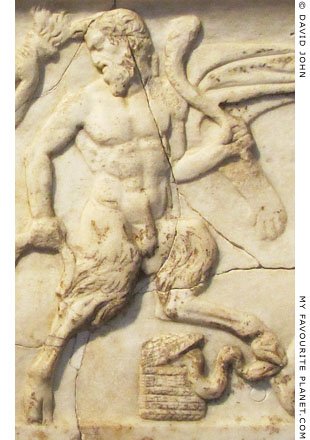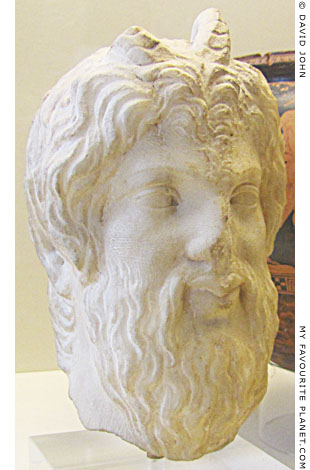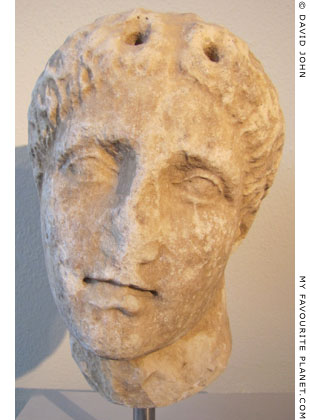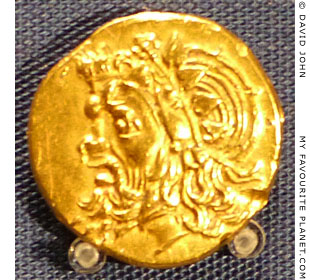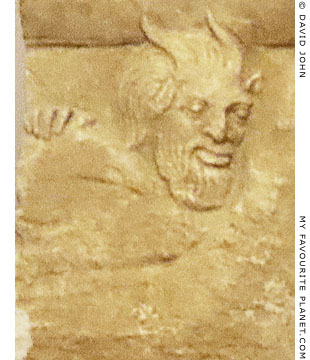| |
In the 5th century BC Herodotus recounted the tale of the Athenian runner Pheidippides meeting Pan at Mount Parthenion in the Peloponnese. The goat-footed god complained that the Athenians had been neglecting him. After they duly dedicated a shrine to him in a cave on the north slope of the Acropolis, he came to their assistance against the Persian invasion at Marathon in 490 BC (see Athens Acropolis gallery page 4). Other sanctuaries were also founded for Pan around Attica, including in a cave near Marathon itself (see below).
Around 600 years later, the Roman author Lucian of Samosata (Λουκιανός ὁ Σαμοσατεύς, circa 125-180 AD) humorously portrayed Pan as a tax-paying naturalized foreigner (metic) in Athens, complaining that the Athenians do not pay him the respect he feels he is entitled to, and criticizing philosophers.
(Justice and Hermes are conversing in the porch of the Academy, Athens.)
Justice: Before you go, Hermes, tell me who this is coming along; a man with horns and a pipe and shaggy legs.
Hermes: Why, you must know Pan, most festive of all Dionysus's followers? He used to live on Mount Parthenius: but at the time of the Persian expedition under Datis, when the barbarians landed at Marathon, he volunteered in the Athenian service; and ever since then he has had the cave yonder at the foot of the Acropolis, a little past the Pelasgicum, and pays his taxes like any other naturalized foreigner. Seeing us so near at hand, I suppose he is coming up to make his compliments.
Pan: Hail, Justice and Hermes!
Justice: Hail, Pan, chief of Satyrs in dance and song, and most gallant of Athens' soldiers!
Pan: But what brings you here, Hermes?
Hermes: Justice will explain; I must be off to the Acropolis on my errand.
Justice: Zeus has sent me down, Pan, to preside in the law court. And how do you like Athens?
Pan: Well, the fact is, I am a good deal disappointed: they do not treat me with the consideration to which I am entitled, after repelling that tremendous barbarian invasion. All they do is to come up to my cave two or three times a year with a particularly high-scented goat, and sacrifice him: I am permitted to look on whilst they enjoy the feast, and am complimented with a perfunctory dance. However, there is some joking and merrymaking on the occasion, and that I find rather fun.
Justice: And, Pan, have they become more virtuous under the hands of the philosophers?
Pan: Philosophers? Oh! people with beards just like mine; sepulchral beings, who are always getting together and jabbering?
Justice: Those are they.
Pan: I can't understand a word they say; their philosophy is too much for me. I am mountain-bred; smart city-language is not in my line; sophists and philosophers are not known in Arcadia. I am a good hand at flute or pipe; I can mind goats, I can dance, I can fight at a pinch, and that is all. But I hear them all day long, bawling out a string of hard words about virtue, and nature, and ideas, and things incorporeal. They are good enough friends when the argument begins, but their voices mount higher and higher as they go on, and end in a scream; they get more and more excited, and all try to speak at once; they grow red in the face, their necks swell, and their veins stand out, for all the world like a flute-player on a high note. The argument is turned upside down, they forget what they are trying to prove, and finally go off abusing one another and brushing the sweat from their brows; victory rests with him who can show the boldest front and the loudest voice, and hold his ground the longest. The people, especially those who have nothing better to do, adore them, and stand spellbound under their confident bawlings. For all that I could see, they were no better than humbugs, and I was none too pleased at their copying my beard. If there were any use in their noise, if the talking did any good to the public, I should not have a word to say against them: but, to tell you the plain unvarnished truth, I have more than once looked out from my peep-hole yonder and seen them -
Justice: Hush, Pan. Was not that Hermes making the proclamation?
Lucian, The Double Indictment (or Trials by Jury; Greek, Δὶς κατηγορούμενος; Latin, Bis Accusatus sive Tribunalia).
The works of Lucian of Samosata Volume III (of four). Translated by H. W. Fowler and F. G. Fowler. Oxford University Press, 1905. At Project Gutenberg. |
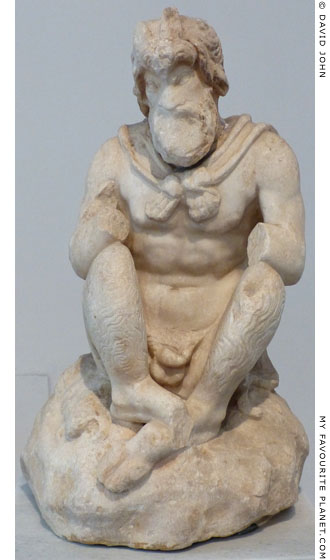
Marble statuette of Pan sitting cross-legged
on a rock covered by an animal pelt.
Pentelic Marble. 2nd century BC, probably
a copy of a 4th century BC work.
Found in the Olympieion, Athens.
National Archaeological Museum, Athens.
Inv. No. 683. |
| |
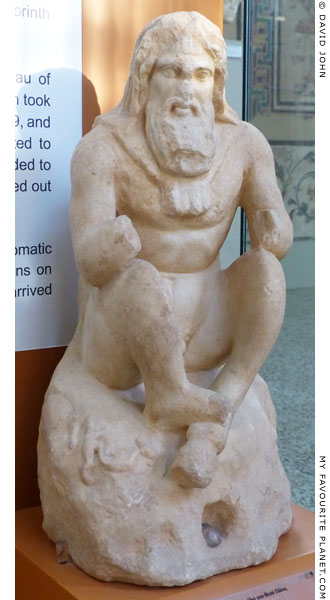
Marble statuette of Pan sitting cross-legged
on a rock covered by an animal pelt.
120-140 AD. Found in the South Stoa
of the Forum of Ancient Corinth.
Corinth Archaeological Museum.
Inv. No. S 2385. |
| |
| |
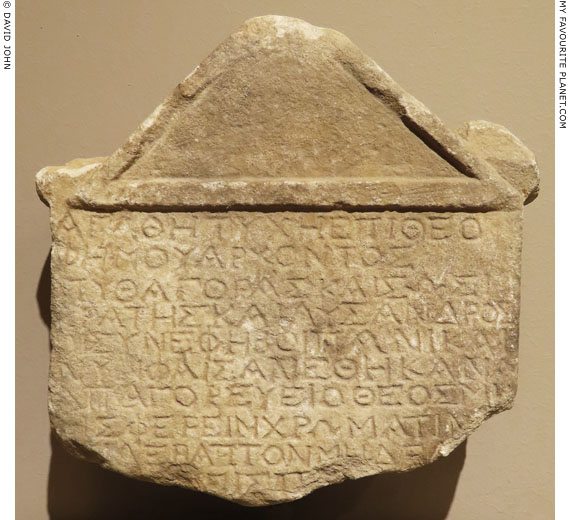
The top part of a marble votive stele of the ephebes (youths aged 18-19 years)
inscribed with the sacred law for cult rituals of the worship of Pan. From the
Cave of Pan (Σπήλαιο Πανός) at Oinoe (Οινόη, Vineyard), in the eastern foothills
of Mount Penteli, around 3 kilometres west of Marathon, east Attica.
Set up during the archonship of Theophemus, circa 61/60 BC.
The surviving part of the text appears to forbid the wearing of colourful
garments within the sanctuary, similar to regulations at other sanctuaries
in which only white clothing was permitted.
ἀγαθῇ τύχῃ· ἐπὶ Θεο
φήμου ἄρχοντος
Πυθαγόρας καὶ Σωσι
κράτης καὶ Λύσανδρος
οἱ συνέφηβοι Πανὶ καὶ
Νύμφαις ἀνέθηκαν.
ἀπαγορεύει ὁ θεός· μὴ
[ε]ἰσφέρειν χρωμάτιν[ον]
[. . .] [μ]η̣δὲ βαπτὸν μηδὲ Λ[. . .]
[. . .] ΕΙΣΠ [. . .] |
|
Good Fortune. In the archonship
of Theophemos, fellow ephebes
Pythagoras, Sosikrates and
Lysandros dedicated [this stele]
to Pan and the Nymphs. The god
forbids to take in either coloured
or dyed [garments] or [. . .] |
Inscription SEG 36:267.
Marathon Archaeological Museum. Inv. No. Λ 231.
|
The sanctuary of Pan inside the cave at Oinoe was founded after the Athenian victory over the invading Persian army of Darius I at the Battle of Marathon in 490 BC (History of Stageira and Olympiada, part 4). Archaeological finds point to human activity in the cave from the 6th millennium BC (Neolithic period) to the 6th century AD (Late Roman period).
The stele was found during the first excavation of the cave by the Greek archaeologist Ioannis ("John") K. Papadimitriou (Ιωάννης Κ. Παπαδημητρίου, 1904-1963), shortly after he rediscovered it in 1958. His search for the cave's location was inspired the brief description by the ancient Greek travel writer Pausanias (second century AD):
"A little beyond the plain [of Marathon] is the Hill of Pan and a remarkable Cave of Pan. The entrance to it is narrow, but farther in are chambers and baths [λουτρὰ, loutra] and the so-called 'Pan's herd of goats', which are rocks shaped in most respects like to goats."
Pausanias, Decription of Greece, Book 1, chapter 32, section 7.
The "loutra" are thought to have been small, round cavities in the rocks which held water. "Pan's herd of goats" were probably the cave's stalagmites, imagined to resemble goats.
Unfortunately, Papadimitriou died suddenly just five years after discovering the cave, and his findings were not published. The stele's inscription was first published twenty years later in 1978 by his colleague Vasileios Petrakos (Βασίλειος Πετράκος).
Present dimensions of the stele: height 22 cm, width 20.7 cm (22.9 cm at the base of the pediment), thickness 4.4 cm. Dimensions of the text: letter height 1 - 1.2 cm; Ω 0.5 – 0.6 cm; Φ 1.5 cm; interlinear space 0.2 – 0.4 cm. |
|
| |
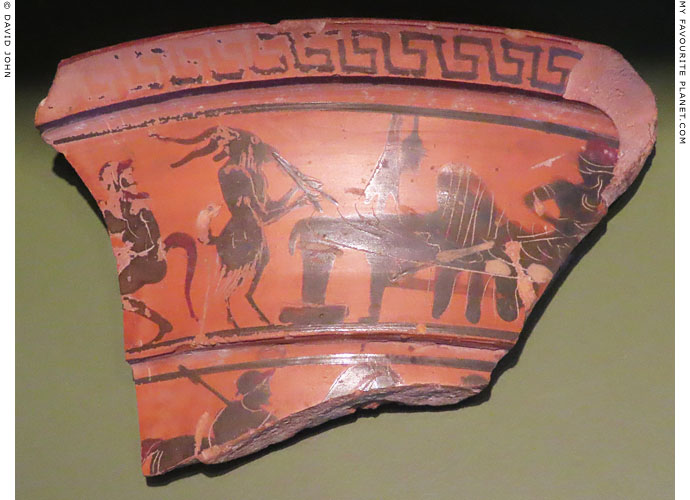
A sherd (fragment) of an Athenian black-figure volute krater with a depiction of Pan
as a goat standing on his hind legs, with human arms and hands which he uses to
play a diaulos (double pipes) at a divine symposium. Behind him, left, a Satyr appears
to be dancing. On the right Hermes lounges on a kline (couch), looking behind him
to the right, perhaps towards Dionysus who is shown on another kline on a second
fragment of the krater (Inv. No. 2118) with a Maenad and another Satyr.
Made in Athens around 500-490 BC (the year of the Battle of Marathon).
Allard Pierson Museum, Amsterdam. Inv. No. 2117.
|
This is one of two vase paintings claimed to be the earliest known surviving representation of Pan, perhaps surprisingly created in Athens rather than in his home in Arcadia.
The other is an Attic black-figure neck amphora in the manner of the Red-Line Painter, showing Pan as a goat, standing on his hind legs, beside a woman (maybe a Maenad). Around 500-490 BC. Height 25 cm. South Africa Museum, Cape Town. Inv. No. HW1. [5]
It has been argued that the god's goat-like form may have been invented in Attica around this time. Other Attic vase paintings from the first half of the 5th century BC also depict Pan as more goat than man, including:
An ithyphallic goat-headed Pan pursuing a goatherd on an Attic red-figure bell krater, the name-vase of the Pan Painter, circa 470 BC. Museum of Fine Arts, Boston. Inv. No. 19,185.
Two Pans at the anodos (rising from the underworld) of a goddess on an Attic red-figure Skyphos, circa 460 BC. Museum of Fine Arts, Boston. Inv. No. 01.8032.
Pan is also shown with a goat's head on an early 5th century BC black-figure skyphos from the Kabirion of Thebes, Boeotia. Now in the National Archaeological Museum, Athens.
See also a Arcadian bronze figurine, around 440-400 BC, of Pan with a goat's head below.
The worship of Pan is thought to have become more widespread in Attica after the Battle of Marathon in 490 BC (see above), and as his cult developed images of him also evolved into his more familiar anthropomorphic form by artists during the Classical period in the 5th - 4th centuries BC.
It has been suggested (for example by Ulrich Hübinger, see note 7) that other, more ancient Archaic figures, usually identified for example as Satyrs or animals, may be depictions of demonic Pan, as he was imagined before 5th century artists took an interest in him.
In later Greek and Roman art Pan was most often depicted in human form, apart from goat's horns, legs and hoofs, and sometimes with a tail. He was rarely shown with a goat's head, the theriomorphisic (human-animal hybrid) type of representation of a god usually associated with other ancient cultures, especially Egyptian. |
|
| |

Arcadian bronze statuette of a shepherd
dedicated to Pan by Phauleas (Φαυλέας).
Around 550-500 BC. Height 10.1 cm.
Perhaps from the sanctuary of Pan at Neda.
The inscription on the base:
Φαυλέας ἀνέθυσε τõι Πανί
Phauleas dedicated (this) to Pan.
Inscription IG V,2 555.
Metropolitan Museum of Art,
New York. Inv. No. 08.258.7.
Acquired in 1908 using the Rogers fund.
|
|
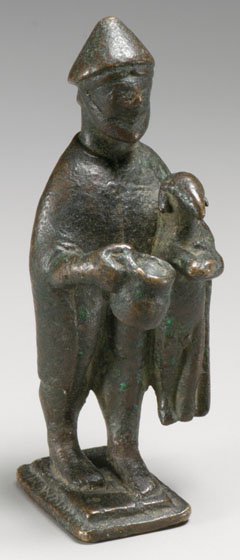
Arcadian bronze statuette of a shepherd
dedicated to Pan by Aineas (Αἰνέας).
Around 525–500 BC. Height 9.2 cm.
Perhaps from the sanctuary of Pan at Neda.
The inscription on the base:
Πανί Αἰνέας
Aineas [dedicated me] to Pan. [6]
Metropolitan Museum of Art,
New York. Inv. No. 43.11.3.
Acquired in 1943 using the Rogers fund.
|
Public domain photos courtesy of Metropolitan Museum of Art, www.metmuseum.org.
|
|
Both bronze statuettes are inscribed on their bases with private dedications to Pan and, along with inscriptions on a ceramic sherd and a small marble base (see below), provide the oldest surviving written evidence for the worship of the god discovered so far. They are thought to come from a rural sanctuary of Pan at Neda (formerly Berekla), near Andritsaina (Ανδρίτσαινα) in southwestern Arcadia, Peloponnese.
At the beginning of the 20th century a number of ancient Arcadian artefacts, including bronze statuettes, discovered by local people (described as "peasants") began appearing illegally on the international art market. Some of these objects, including a bronze figurine of Hermes Kriophoros (Athens, Inv. No. 12347), were confiscated by Greek authorities, but others were taken abroad and are now in collections and museums around the world. Many, if not all, were thought to have come from the scant ruins of the sanctuary at Neda, and in 1902 the Greek Archaeological Society organized the first excavation of the site, led by Konstantinos Kourouniotis (Κωνσταντίνος Κουρουνιώτης, 1872-1945). Among the finds were two 6th century BC votive dedications to Pan, inscribed on a ceramic sherd (TOI ΠΑΟΝΙ) and a small marble base for a bronze statuette (ΠΑΝΟΣ). Both are now in the National Archaeological Museum, Athens. As well as Pan, it seems that Hermes was also worshipped there, and possibly a third deity, perhaps Apollo. [7]
The statuette dedicated by Phauleas (left) is thought to have been taken from the sanctuary at Neda (Berekla) before Kourouniotis' 1902 excavations by Konstantinos. The figure dedicated by Aineas is of uncertain provenance, possibly from Neda (Berekla), but is described as being "from Andritsaina in Arcadia" and "once in the London market".
Each of the bearded male figures is naked apart from a conical hat (ϰυνέη) and a short shepherd's cloak, fastened at the chest by large pin. Each steps forward with his left foot, carrying offerings to the god. The objects held by the Phauleas figure are lost, but the figure dedicated by Aineas holds a jug in his right hand and a ram with his left hand. As is often the case with Archaic sculptures, it is not clear whether the figures were intended to represent a god, a generic worshipper or perhaps the dedicant himself. While these statuettes slightly resemble those usually identified as Hermes Kriophoros, they have been taken to be shepherds bringing sacrificial offerings.
Perhaps surprisingly, only one representation of Pan himself is known to have been found at the Neda site, a bronze figurine dated to the 5th - 4th century BC. The god is shown as a naked human youth with small horns on the top of his head. His left forearm and hand are now missing, as well as part of the right hand. National Archaeological Museum, Athens. Inv. No. 13063. [8] |
|
| |
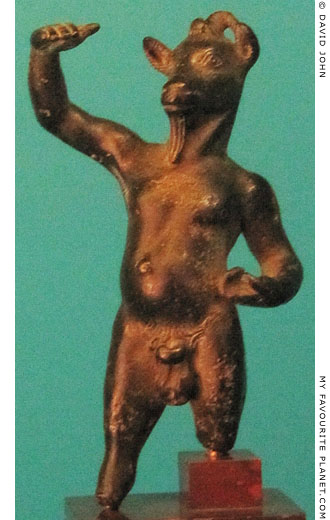
Bronze figurine of Pan with a goat's head,
raising his right hand to shade his eyes
as he looks far across the countryside.
Around 440-400 BC. From the sanctuary
of Artemis Hemera at Lousoi (Λουσοί),
Arcadia, south of the modern town of
Kalavryta (ancient Kynaitha), Achaia,
Greece. Height 9.4 cm.
The site of Lousoi on the south side of
Mount Lykaion, mentioned by Pausanias
(Description of Greece, 8.18.7), was discovered
in 1897 by archeologists Wilhelm Dörpfeld
and Adolf Wilhelm. The latter excavated the
Artemis sanctuary with Wolfgang Reichel
1898-1899 for the Austrian Archaeological
Institute at Athens. It is apparently not known
how this and other finds ended up in Berlin.
Antikensammlung, Berlin State Museums (SMB).
Inv. No. Misc. 8642,1. Acquired in 1898. |
|
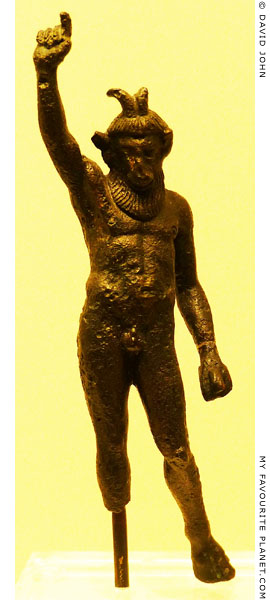
Bronze figurine of Pan, thought to be
depicted in a dancing movement and
perhaps snapping the fingers of his
raised right hand. In his left hand
he originally held a lagobolon.
450-440 BC. From the sanctuary of
Zeus, Olympia, Peloponnese, Greece.
Pan was still worshipped at Olympia
until the final years of the sanctuary
at the end of the 4th century AD, and
two altars were dedicated to him there.
Olympia Archaeological Museum. |
|
| |
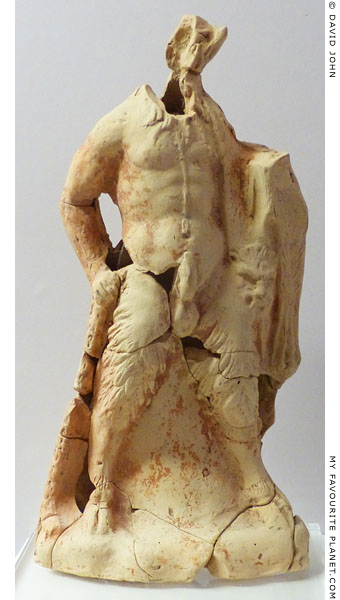
A fragmentary terracotta votive figurine of Pan.
Late 3rd century BC. Found in the Leonidaion
at the Sanctuary of Zeus, Olympia, Greece.
The ithyphallic figure stands with his goat's
legs astride and appears to be leaning back
against a rock or tree stump. In his lowered
right arm he holds one end of his lagobolon,
the other end of which rests on the ground.
His left shoulder and arm are covered by an
animal skin on which there is the face of
what appears to be a lion.
Olympia Archaeological Museum. |
|

A bronze stylus with a handle in
the form of Pan playing his syrinx.
The front of the upper end (eraser)
is decorated with a palmette.
An inscription on the back states
that it was dedicated by Anthemos
to the Child and Kabiros.
Around 400-350 BC. Possibly from
the sanctuary of the Kabiroi, Thebes.
National Archaeological Museum,
Athens. Inv. No. 7848. |
|
| |
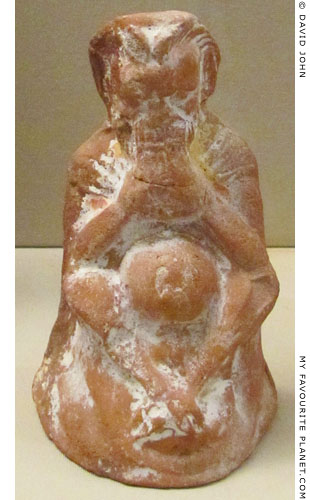
Small terracotta figurine of Pan playing his
syrinx, sitting with crossed goat's feet on
a rock. He wears an animal-skin cloak. [9]
Classical-Hellenistic period.
Found in Amphipolis, Macedonia.
Amphipolis Archaeological Museum. |
|
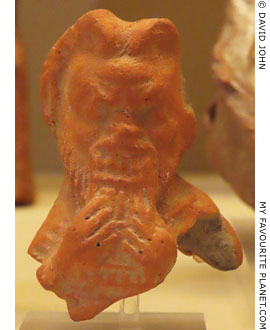
Fragment of a terracotta figurine
of Pan playing his syrinx.
2nd century BC. From Abdera,
Thrace, northeastern Greece.
Abdera Archaeological Museum.
See also a terracotta statuette
from Abdera below. |
|
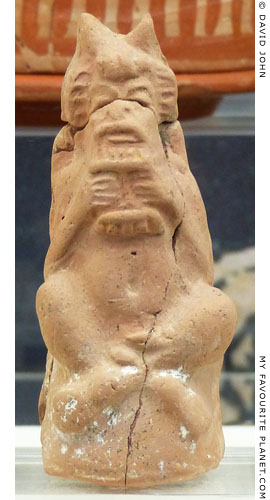
Terracotta figurine of Pan playing
his syrinx, sitting with crossed
goat's feet on a rock.
Around 400 BC. From Kerameikos,
Athens. Height 9.5 cm.
Kerameikos Archaeological
Museum. Inv. No. T 1057. |
|
| |
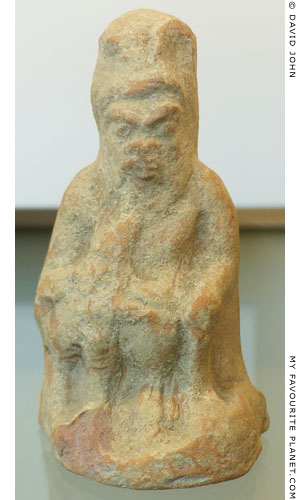
Small terracotta votive figurine of Pan
holding his syrinx (pan pipes).
Made in Sicily around 410 BC.
Excavated by G. Dennis at Gela, Sicily.
British Museum.
GR 1863.7-28.281 (Terracotta 1169). |
|
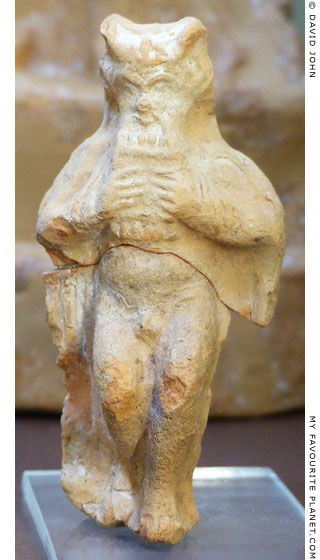
Terracotta votive figurine of Pan, walking
or dancing and playing his syrinx.
Around 400-350 BC. From the Cave of
the Leibethrid Nymphs, at Agia Triada,
near Koroneia, Boeotia, central Greece. [10]
Thebes Archaeological Museum. |
|
| |
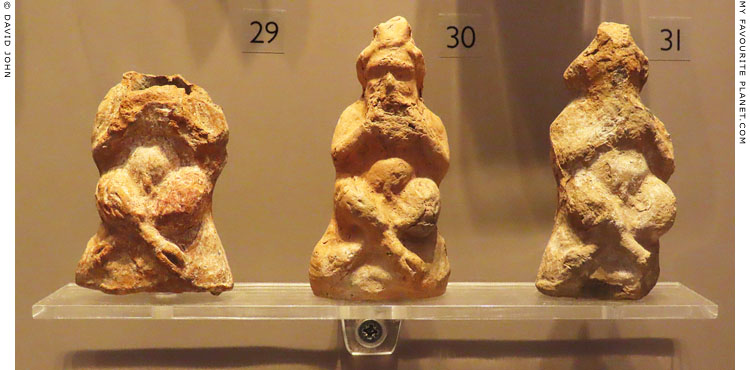
Three ceramic votive figurines of bearded Pan, sitting cross-legged on a rock, playing
a syrinx. As with the figurine from Amphipolis above, the museum labelling states that
this is Silenos "squatting". However, the figure clearly has cloven hoofs [see note 9].
4th century BC. Found in a cave at Aspri Petra, Kos, a sanctuary dedicated to the
Nymphs, Pan and Demeter. The cult of Pan is thought to have been introduced
here in the late 5th - early 4th century BC.
Kos Archaeological Museum. |
| |
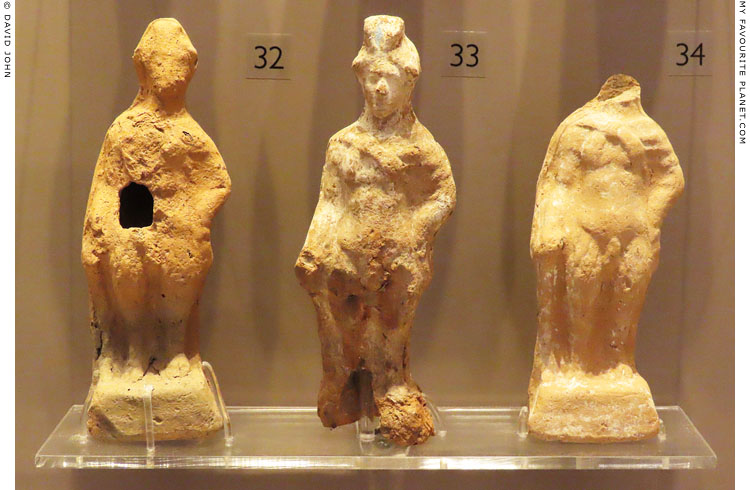
Three ceramic votive figurines of beardless Pan, standing naked apart from
an animal skin over his shoulders, fastened by a knot below the throat.
4th century BC. Found in the cave sanctuary at Aspri Petra, Kos (see above).
Kos Archaeological Museum. |
| |
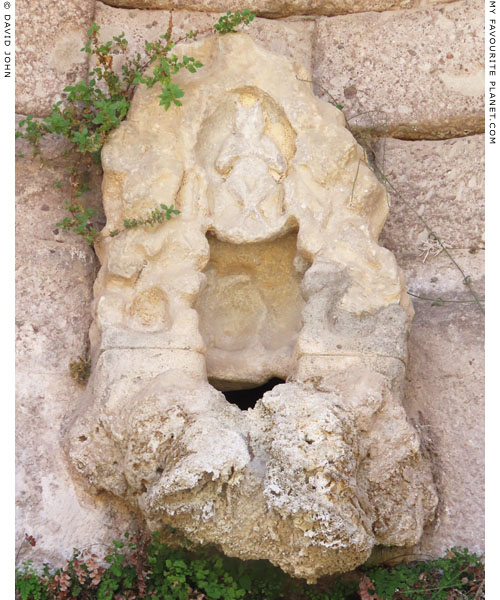 |
|
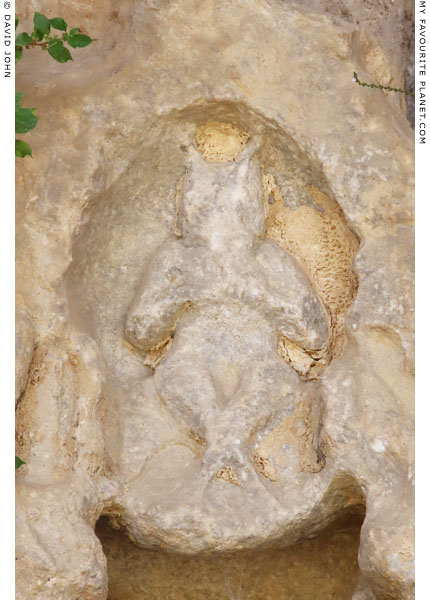 |
A relief of Pan sitting cross-legged and playing his syrinx above the entrance to an artificial
grotto and spring constructed over a water tank in the Asklepieion on Kos. Roman period.
Pan's features and details of other carving around the grotto are now badly worn. There
appear to be the remains of other figures either side of Pan, but they are no longer clear.
In situ on the lower terrace of the Asklepieion archaeological site, Kos, Dodecanese, Greece. |
|
| |
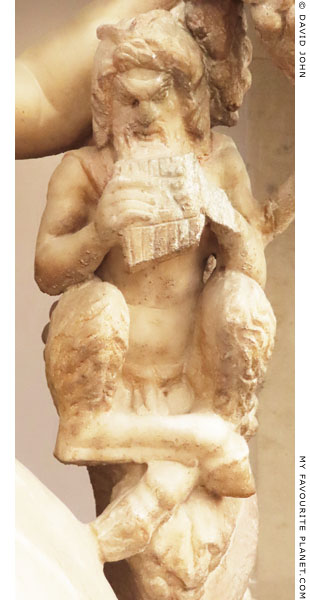
Marble figure of Pan sitting cross-legged on
top of a vine-covered tree stump, playing a
syrinx (pan pipes). Part of a statue group of
drunken Dionysos, a Satyr, Pan, Eros and
a panther (see Dionysus).
150-200 AD. Found in June 1937 in the
"House of the Rape of Europa" in Kos Town,
during excavations by Italian archaeologist
Luigi Morricone (see Hermes).
Kos Archaeological Museum. Inv. No. 94. |
|
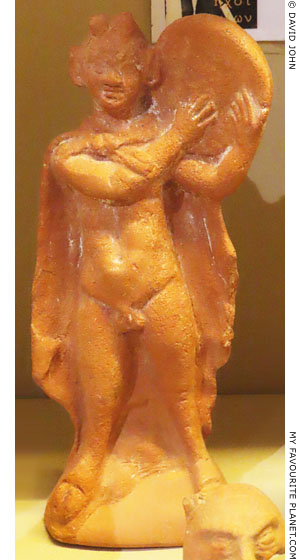
Terracotta statuette of a youthful,
beardless Pan or a Satyr playing a
tympanon (τύμπανον, hand drum). [11]
From Abdera, Thrace, northeastern
Greece. 4th or 3rd century BC (?).
The figure is naked apart from a long
cloak, knotted below his throat. He has
horns on top of his head, large ears,
pointed at the top, and goat's legs and
feet. He stands with his legs apart,
facing frontally. With his left hand he
holds the tympanon, which rests on his
left shoulder and bent arm. His right
hand is placed on the drum's skin.
Abdera Archaeological Museum.
Inv. No. 1161. |
|
| |
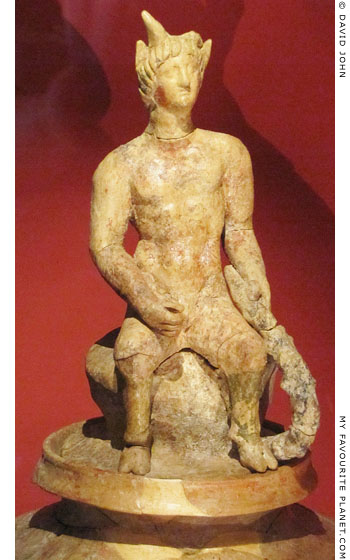 |
|
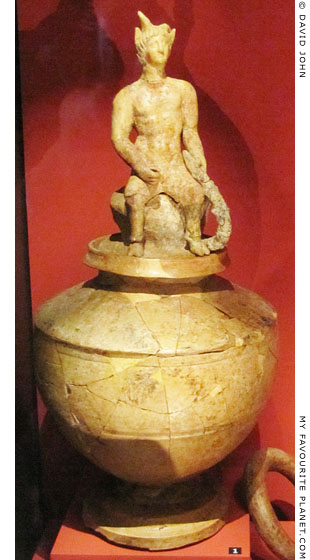 |
A ceramic nuptial lebes, the lid of which is in the form of a figure of Pan,
sitting on a rock and holding a lagobolon in his left hand.
4th century BC. One of several vessels from a Samnite cremation burial,
found in Tomb 23 in the necropolis at Larino, the location of the Samnite
city Larinum, Campobasso province, Molise region, south-central Italy. [12]
The two circular handles of the lebes, which have survived but are broken off,
are in the form of snakes, thought to be related to the cult of Dionysus,
adopted by the Samnites from the Greeks in Magnae Graecia (southern Italy).
See also:
the head of Hermes on the lid of a ceramic vessel from Larino
Dionysian imagery on ancient artefacts from Samnium |
|
| |
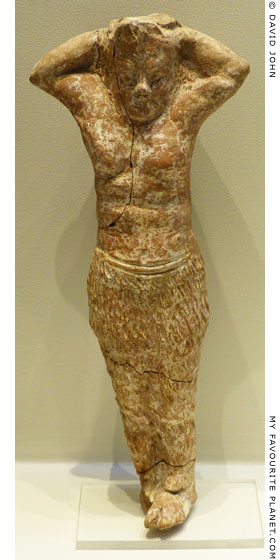
An unusual terracotta figurine of Pan
with his arms raised above his head.
Excavated in the area of the
Thesmophorion of Pella,
Macedonia. 4th - 2nd century BC.
Pella Archaeological Museum. |
|
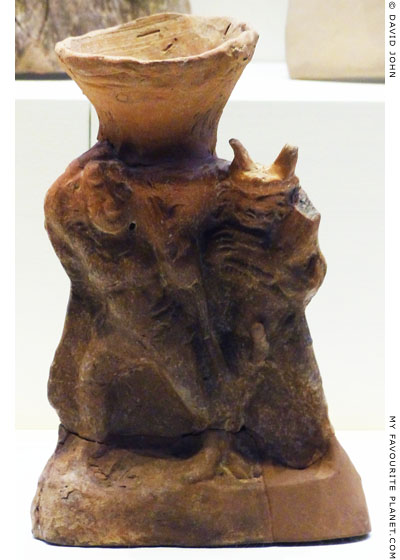
A terracotta incense burner with figures
of a Satyr (left) and Pan golding a syrinx.
Excavated in Pella, Macedonia.
Pella Archaeological Museum. |
|
| |
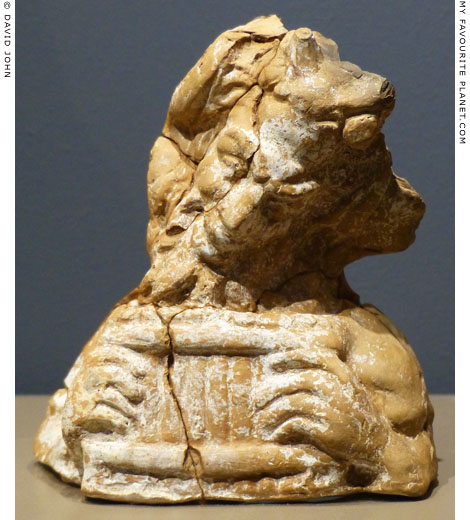
Terracotta incense burner in the form of a bust of Pan playing a syrinx.
From the Sanctuary of the Mother of Gods, Lefkopetra,
Imathia, Macedonia, Greece. 3rd - 2nd century BC.
Thessaloniki Archaeological Museum. |
| |
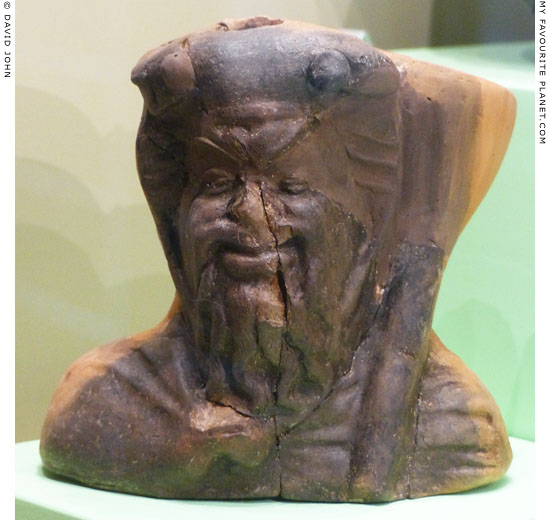
Ceramic censer (incense burner) in the form of a bust, described by
the museum as a Satyr. The object on his left shoulder resembles
the kind of trumpet Pan is shown holding on some vase paintings.
Hellenistic period. From Lefkopetra, Imathia, Macedonia, Greece.
Veria Archaeological Museum. Inv. No. Π 8610. |
| |
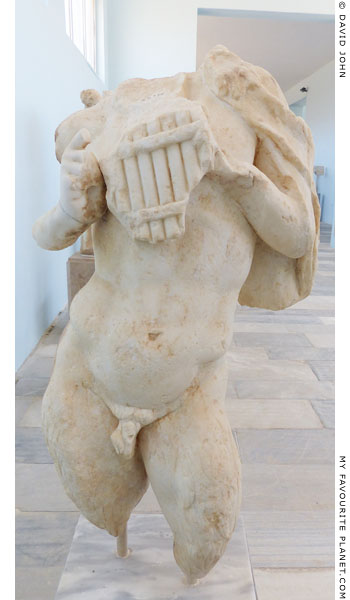
Marble statuette of Pan holding a syrinx
From the Stoa of Antigonos, Delos. 150-100 BC.
Delos Archaeological Museum. Inv. No. 4138. |
|
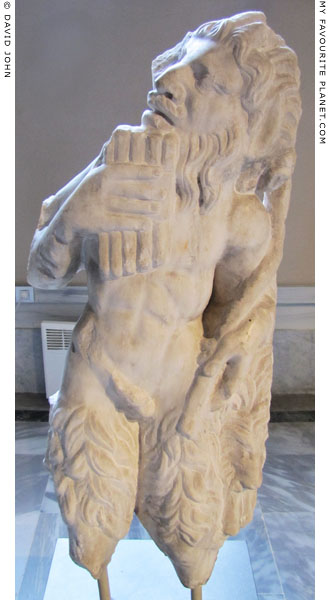
Marble statuette of Pan playing his syrinx
and holding a lagobolon in his left hand.
Originally part of a statue group.
Roman, Early 3rd century AD. From Tirnovo
(Veliko Tarnovo, Bulgaria). Height 67.5 cm.
Istanbul Archaeological Museum.
Inv. No. 26 T. Cat. Mendel 593. |
|
| |
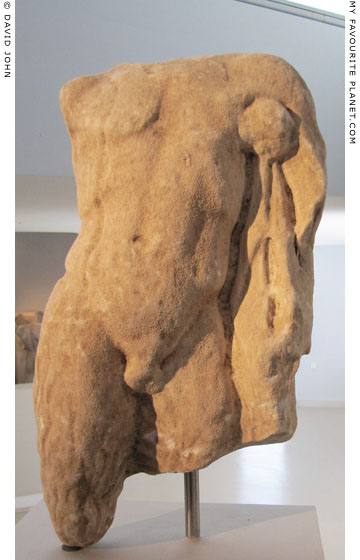
Torso of a statuette of Pan from Thasos.
From the Passage of the Theoroi, Thasos.
Late 3rd - early 2nd century BC.
Thasos Archaeological Museum. |
| |
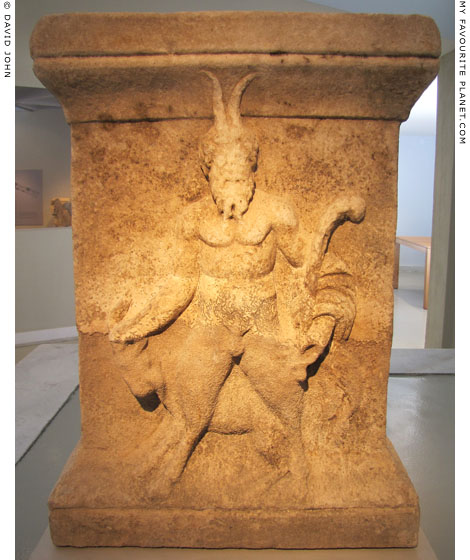
Altar with an ithyphallic relief of Pan from Thasos.
Found in the ancient city of Thasos, Greece. 1st - 2nd century AD.
Thasos Archaeological Museum.
|
| Pan, bearded and naked, is shown with long, upright horns an erect penis. He is standing in front of, or perhaps sitting on a goat and holding it by its horns with his right hand. In his left hand he holds a hefty-looking lagobolon, a hunting stick for throwing at hares. A cloak, perhaps of animal skin, hangs from his left forearm. Now badly worn, when first carved, and presumably painted, this relief must have been an impressive work. |
|
| |
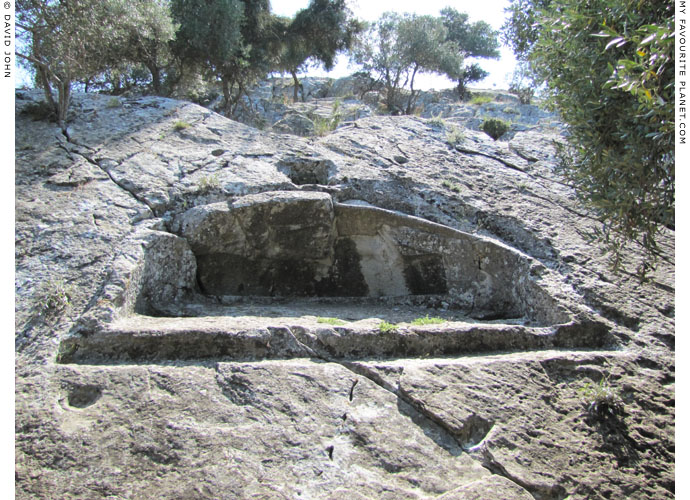
The rock-cut shrine of Pan (το ιερό του Πάνα) on the acropolis of Thasos.
Dated on stylistic grounds to the first half of the 4th century BC.
|
The remains of a very low relief of a banqueting scene on the shrine are now almost impossible to make out.
A semicircular cavity, hewn in the sloped rockface, contains the relief in the form of a temple pediment, within which Pan rests on a rock, playing his syrinx in a rural setting, flanked on either side by three standing goats. On the pediment's roof two goats face each other on either side of a kantharos (drinking cup) on the apex. Vine branches above the pediment and offering tables with vine vessels at each end of the cavity indicate Pan's close association with Dionysus.
"It is not proper for herdsmen to play the syrinx at midday.
I fear Pan who is now resting after the tiring hunt."
Theocritus, Idylls, I, 15-18. 3rd century BC. |
|
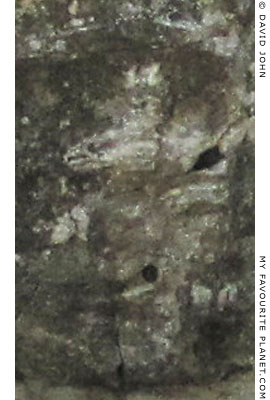
The small figure of Pan playing his
syrinx on the Thasos shrine relief. |
|
| |
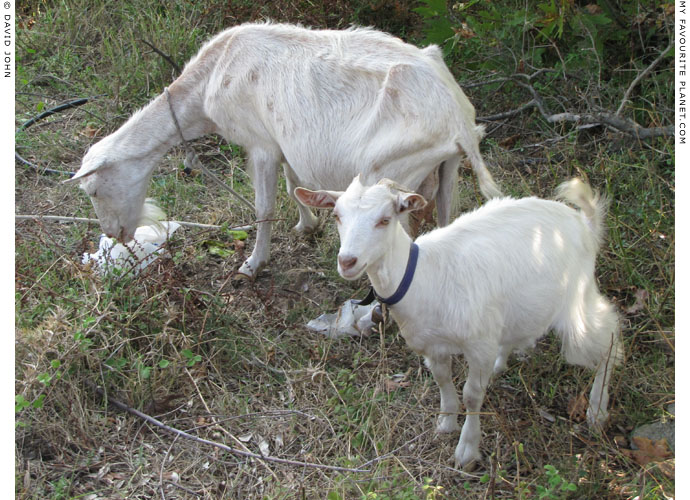
A nanny-goat and her kid in a field on the edge of Thasos town. |
| |
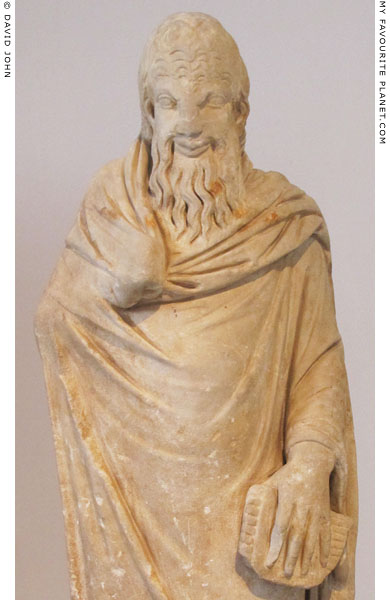 |
|
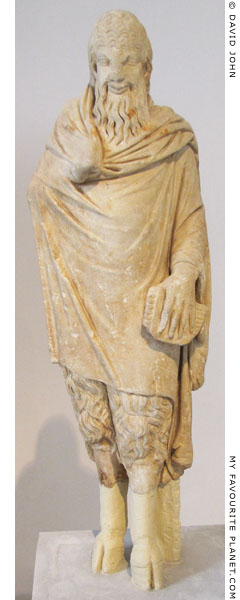 |
Marble statue of Pan.
Parian marble. 1st century AD copy of a 4th century BC original.
Found in Sparta, Peloponnese, Greece.
Smiling Pan wears an animal skin cloak and holds his pan pipes (syrinx)
in his left hand. His goat's legs and feet have been restored.
National Archaeological Museum, Athens. Inv. No. 252. |
|
| |
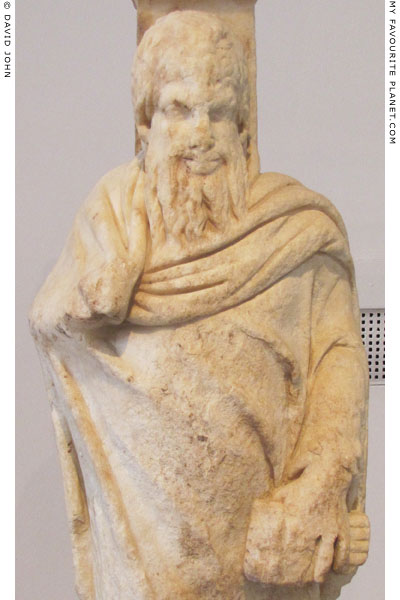 |
|
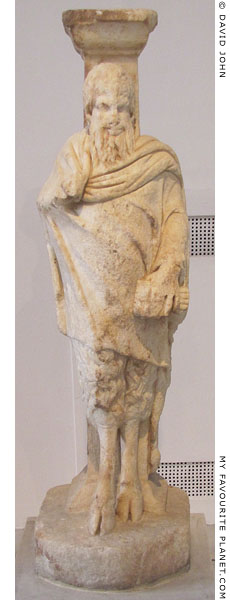 |
Marble table support in the form of a pillar, with a depiction of Pan.
Pentelic marble. 2nd century AD copy of a 4th century BC original.
Found in Piraeus, Attica, Greece.
Similar to the statue above, with Pan wearing an animal skin
as a cape and holding his syrinx in his left hand.
National Archaeological Museum, Athens. Inv. No. 251.
Part of another marble statue of this type, without its head, was
found by Edward Daniel Clarke (1769-1822) near the Cave of Pan
on the north slope of the Athenian Acropolis, and is now in the
Fitzwilliam Museum, Cambridge, Inv. No. GR.4.1865. [13]
Another is in the Sikyon Archaeological Museum, west of Corinth. |
|
| |
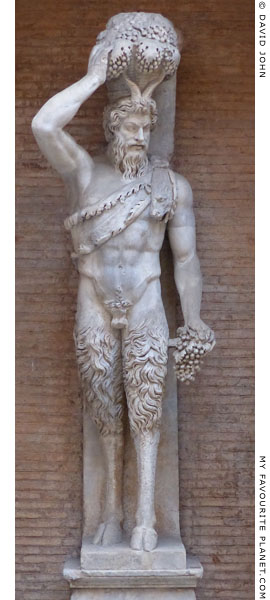 |
|
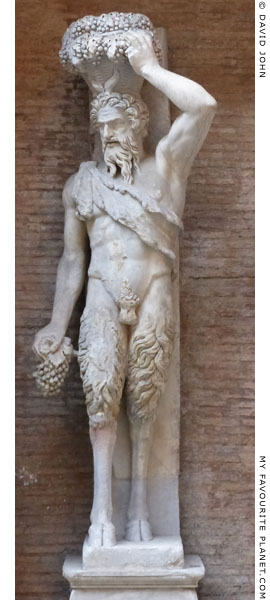 |
Two symmetric marble statues of Pan, known as the "Della Valle Satyrs".
The statue on the right is perhaps an original of the late Hellenistic period.
That on the left may be a Roman period copy, perhaps 2nd century AD.
Left, Luna marble. Height 283 cm. Right, Greek marble. Height 279 cm. Courtyard, Palazzo Nuovo, Capitoline Museums, Rome. Inv. Nos. MC 4 and MC 16.
From the Della Valle Collection, then the Albani Collection.
|
|
The statues, which may have been telamons (architectural supports, like caryatids), were discovered in the 1490s in the area of the Theatre of Pompey, in the Campus Martius, Rome. The square at the location where they are thought to have been discovered became known as the "Piazza dei Satiri".
They were first part of the collection of Cardinal Andrea della Valle (1463-1534), hence the name "Della Valle Satyrs". During the 16th century were displayed among several other ancient sculptures in the courtyard of Palazzo Della Valle, where they were drawn and copied by a number of artists. Originally without lower arms, they were restored by Giovanne da Udina (1487-1564) to decorate a pilaster in the garden of the palazzo. In 1513 they were temporarily employed as decoration for a triumphal arch in the Via Papale to celebrate the accession of Pope Leo X.
Later they were in the collection of Cardinal Alessandro Albani for a short period before being moved to the Capitoline Museum in 1734. They now stand in niches in the Cortile (Courtyard), on either side of the Marforio fountain (from the Martis Forum), which features a colossal 2nd century AD statue of a river god restored to represent the god Okeanos (Inv. No. MC 1).
Both statues show Pan standing naked apart from a nebris (panther skin, see Dionysus) around one shoulder and upper torso. In one hand he holds a bunch of grapes, and with the other supports a basket of grapes which rests on his head.
Although the figures mirror each other, there are several differences, particularly the heads and treatment of the surfaces. It is thought that at least one of the figures was reworked. Recent research indicates that they were decorative rather than supportive, and it is now doubted that they were part of the sculptural decoration of the Theatre of Pompey. It has been suggested that they stood at the Temple of Bacchus. |
|
| |
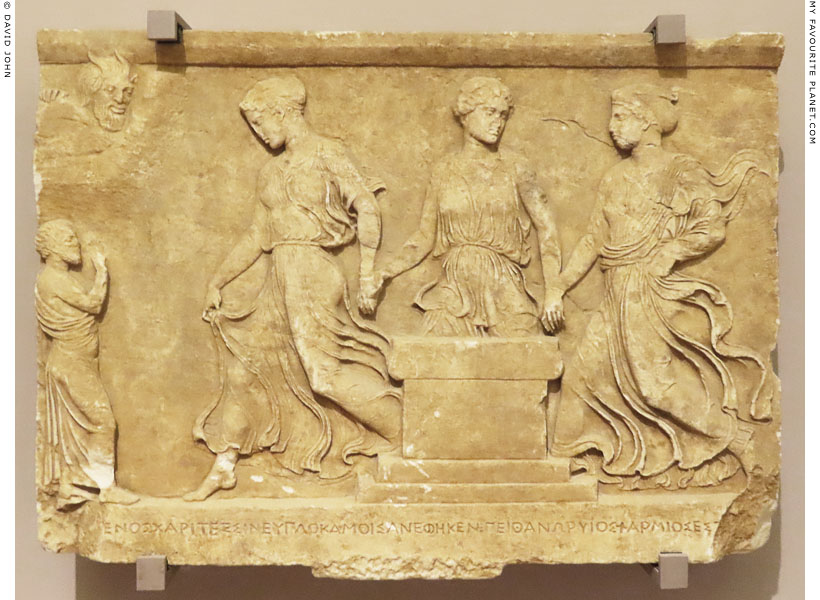
The head of Pan appears in an inscribed marble votive relief dedicated to the temenos
(sanctuary) of the Graces (Greek, Χάριτες, Charites; Latin, Gratiae, Graces) at Mesaria,
Kos, by Peithanor, son of Charmios. The dedicatory inscription runs along the framing
ledge at the bottom of the relief, both ends of which are now missing.
[ΕΥΞΑ]ΜΕΝΟΣ ΧΑΡΙΤΕΣΣΙΝ ΕΥΠΛΟΚΑΜΟΙΣ ΑΝΕΘΗΚΕΝ ΠΕΙΘΑΝΩΡ ΝΟΙΣ ΧΑΡΜΙΟΣ ΕΣ Τ[ΕΜΕΝΟΣ]
Wishing for the fair-haired Charites, dedicated by Peithanor, son of of Charmios, to the temenos.
The three Graces, wearing transparent body-clinging garments, walk or dance swiftly to the left,
hand in hand, passing behind an altar. At the lower left, a bearded man in a himation, presumably
the dedicator Peithanor, depicted at a much smaller scale, stands facing the Graces with his right
hand raised in greeting or supplication. As with other similar votive reliefs depicting Pan with the
Nymphs or Seasons (see below and the Hermes page), the scene is probably set in a cave or
underground sanctuary. This would explain why only Pan's head and the fingers of his right hand
are visible in the top left corner, as he observes the Graces from a hole in the roof of the cave.
Late 5th - early 4th century BC. Found in Mesaria (Mεσαρια), northeastern Kos, Dodecanese.
Kos Archaeological Museum. Inv. No. Γ 1171. |
| |
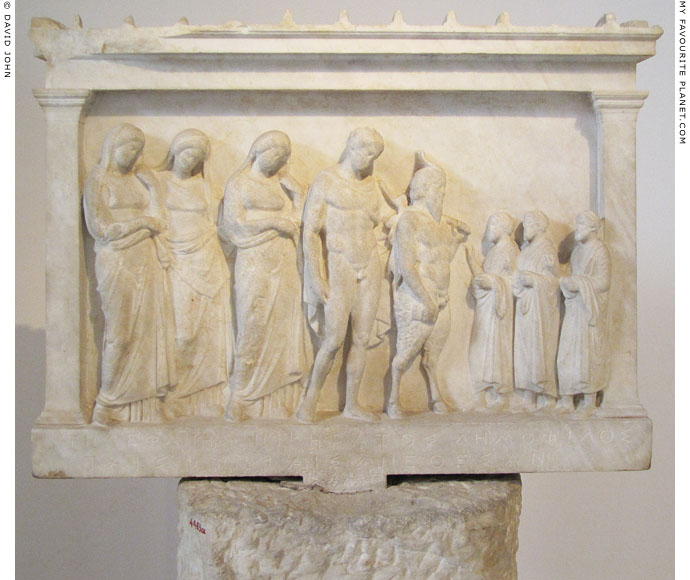
An inscribed marble votive relief dedicated to the Nymphs, around 360 BC.
Found in 1952 in the Cave of the Nymphs, Mount Penteli
(Πεντελικὸν), Attica. Height 53, width 75 cm.
National Archaeological Museum, Athens. Inv. No. 4465.
The separate cylindrical base of the relief, Inv. No. 4465a.
|
This relief was found in the same cave as the relief below (Inv. No. 4466), near the ancient marble quarries on Mount Penteli (Πεντέλη), known in Antiquity as Pentelikon (Πεντελικόν) and also as Brilissos (Βριλησσός, or Brilittos, Βριληττός). It has been suggested that both reliefs may possibly have been made in the same workshop.
The scene is set in a naiskos (ναΐσκος, small temple). On the left are three Nymphs, Hermes and Pan, standing in a row, facing right. The latter holds his pipes (syrinx), a lagobolon and a hare. The inscription below the relief states that it was dedicated by Telephanes, Nikeratos and Demophilos, who are depicted at a smaller scale, as bearded men standing on the right and facing the deities.
Τηλεφάνης, Νικήρατος, Δημόφιλος
ταῖς Νύμφαις ἀνέθεσαν
Telephanes, Nikeratos, Demophilos
Dedicated to the Nymphs
Inscription SEG 12:166.
The earliest known Attic relief dedicated to the Nymphs, around 430-420 BC, was found in the Sanctuary of Asklepios and Hygieia, on the South Slope of the Athens Acropolis. National Archaeological Museum, Athens. Inv. No. 1392.
See similar votive reliefs of Hermes, Pan and the Nymphs on the Hermes page. |
|
| |
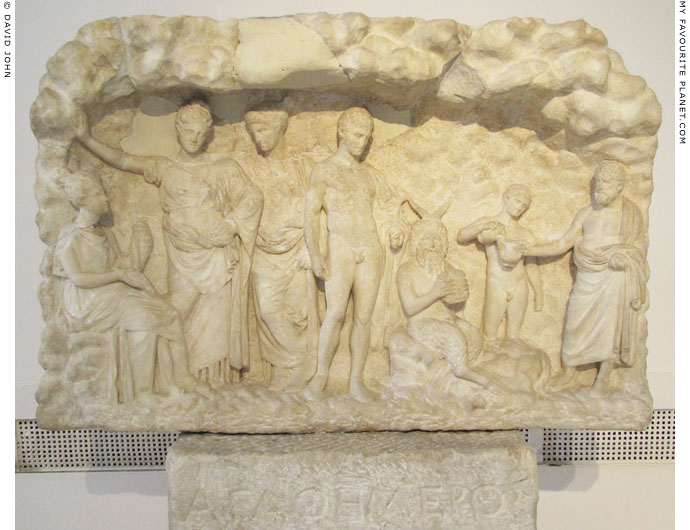
Marble votive relief dedicated to the Nymphs, around 330-320 BC.
Found in 1952 in the Cave of the Nymphs, Mount Penteli, Attica.
Height 70 cm, width 110 cm. Height of base 104 cm.
National Archaeological Museum, Athens. Inv. No. 4466.
|
The scene is similar to the relief above (Inv. No. 4465), except that it is set in a cave. Such votive reliefs set in caves were made from the late 5th to the 1st century BC.
The figures, from left to right: three Nymphs, one sitting and two standing; Hermes standing, wears a chlamys (short cloak) and holds his kerykeion (caduceus) in his left hand; Pan seated on a rock, holds his syrinx (pan pipes); a nude youth pours wine from a oinochoe (wine jug) into the kantharos (wine cup) held by Agathemeros, the dedicator of the relief. As mortals, these last two figures are shown at a smaller scale. The features of the balding, bearded Agathemeros are finely carved, and this may be a portrait. He wears a himation (cloak), and as well as the kantharos in his right hand, he also holds a bunch of grapes in the left. He may be about to offer a libation (a sacrifice of wine).
The three-line dedication is inscribed in large letters on the front of the separate rectangular limestone base on which the relief stands (see photo below).
Ἀγαθήμερος
Νύνφαις
ἀνέθηκε
Agathemeros
to the Nymphs
dedicated [it]
Inscription SEG 29:195. |
|
| |
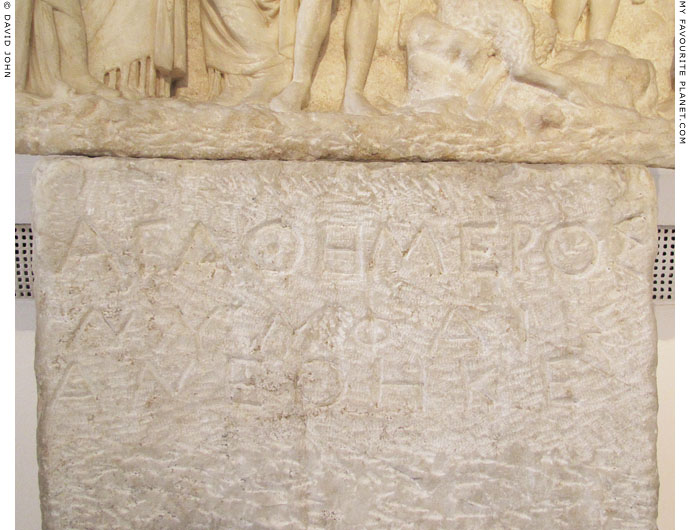
The dedication of Agathemeros to the Nymphs, inscribed on the
rectangular limestone block on which the relief above stood.
National Archaeological Museum, Athens. Inv. No. 4466a. |
| |
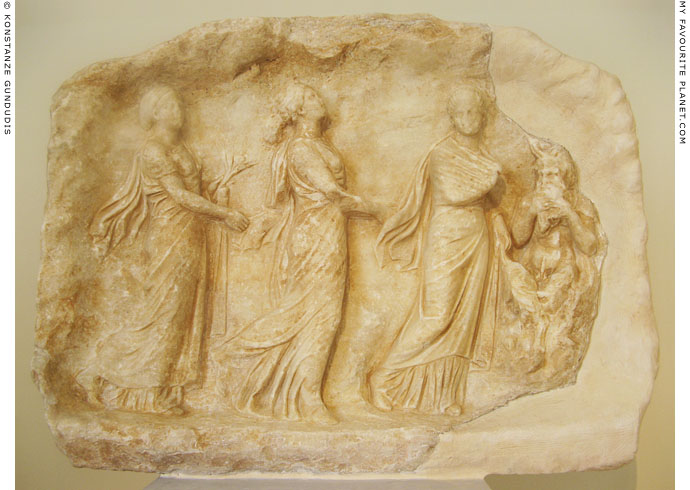
Marble Votive relief depicting Pan with the three Horai (Seasons) in a cave.
330-320 BC. From Sparta (Laconia) or Megalopolis (Arcadia).
Pentelic marble. Height 55 cm, width 73 cm.
National Archaeological Museum, Athens. Inv. No. NM 1449.
|
The Horai (Ὧραι, Horai; singular, Ὧρα, Hora, portion of time, hour, season) were the personifications of the three seasons of ancient Greece who were later seen as goddesses of order and natural justice. They presided over the movements of the heavenly constellations by which the year and agricultural activity were measured, and guarded the gates of Olympus.
Here the Seasons are shown dancing to the music of the syrinx (Pan pipes) played by ithyphallic Pan, who crouches on a rock to their right. They wear long chitons and himatia, the two rear figures holding onto a corner of the garment of the one before her. The seasons from left to right: Spring carries ears of corn in her left hand (harvest), Summer has bare arms, and Winter has drawn her himation around her arm and torso.
They were given different names in various traditions, but most common are two trios, either:
Thallo (Θαλλώ, Bringer of Blossoms), Auxo (Αὐξώ, Increaser, as in plant growth) and Carpo (Καρπώ, Food Bringer);
or Eunomia (Εὐνομία, Good Order, Good Pasture), Eirene (Εἰρήνη, Peace) and Dike (Δίκη, Justice).
The right side and left corner of the relief have been restored with plaster.
Photo © Konstanze Gundudis |
|
| |
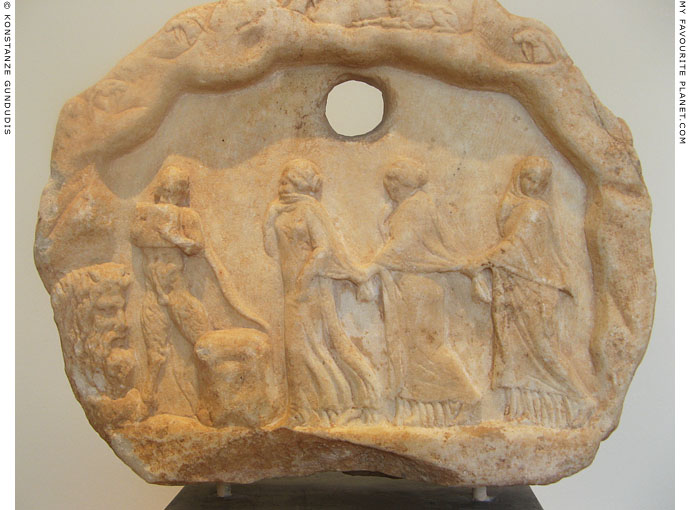
A marble votive relief in the shape of a cave depicting ithyphallic Pan, with goats' legs, wearing
a cloak and playing the syrinx (Pan pipes), followed by three heavily draped Nymphs dancing
around an altar. Around the top of the cave lies a ram flanked by the heads of four goats, and
at the far left is the bearded head of the river god Acheloos, with bull's horns and a wreath.
Late 4th century BC. Found at Eleusis, Attica. Height 27 cm, width 35 cm.
National Archaeological Museum, Athens. Inv. No. 1445.
Photo © Konstanze Gundudis |
| |
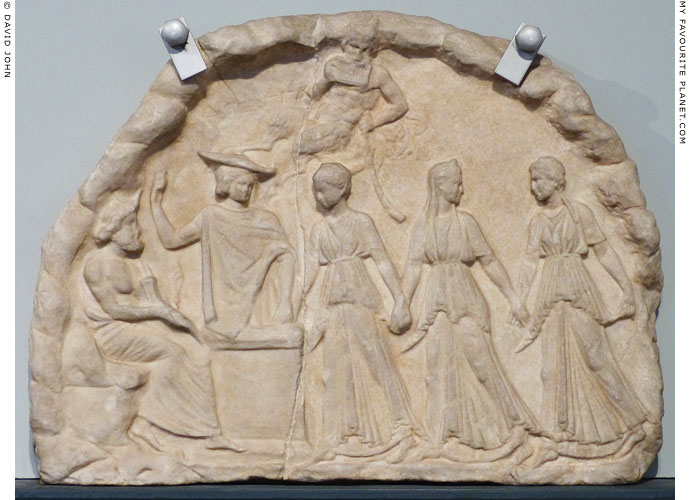
An Archaistic votive relief showing three Nymphs walking or dancing hand-in-hand and being led
by Hermes, as Psychopompos (Guide of Souls), into a cave representing the underworld. They
stand before an altar, to the left of which sits Plouton (Πλούτον, also known as Hades, ᾍδης),
the god of the underworld, holding a rhyton (drinking horn). Pan looks on from above, playing
his syrinx and holding a lagobolon (curved hunting stick). Hermes wears his trademark petasos
(πέτασος, broad-brimmed hat) and a chlamys (χλαμύς, short cloak).
Hellenistic period. Pentelic marble.
Barracco Museum, Rome. Inv. No. MB 176. |
| |
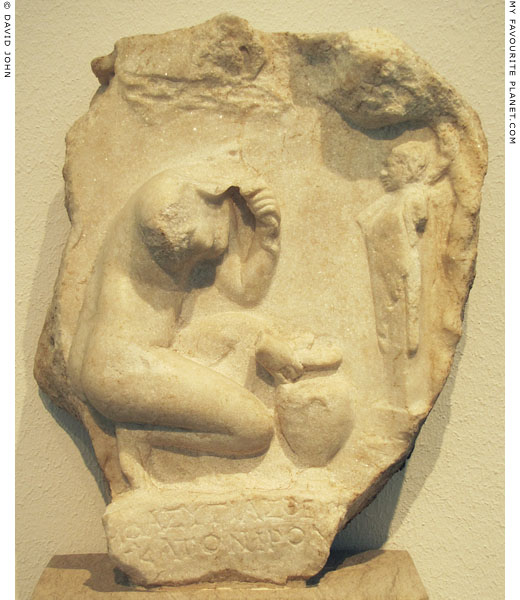
An inscribed marble votive relief depicting a Nymph and a herm of Pan.
Around 100-80 BC. From Tralleis (Aydin, Turkey).
According to the inscription, the relief was dedicated to the Nymph and Pan
in gratitude for a miraculous healing. The crouching, naked Nymph reaches
for a water vessel. Above her a votive plaque hangs from a tree.
Altes Museum, Berlin. Inv. No. Sk 1554. |
| |
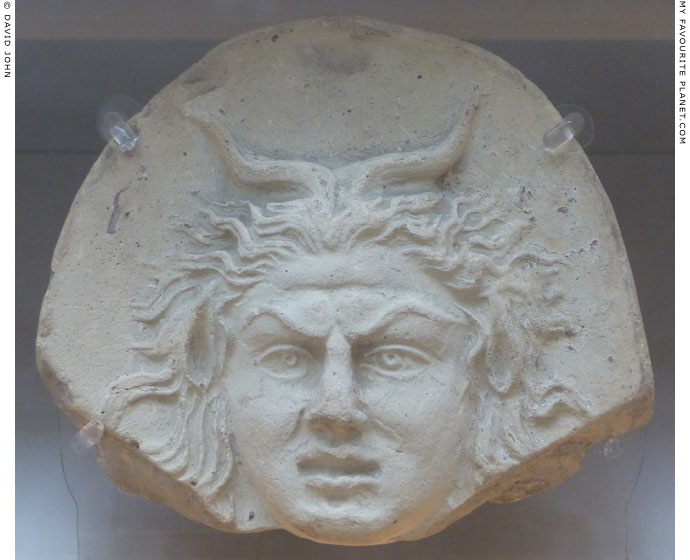
The head of Pan with double-bent horns, pointed ears and
wild spiky locks, on a ceramic antefix (end of a roof tile).
From Taranto, Italy. Around 350 BC.
British Museum. GR 1884.3-22.3 (Terracotta 1364). Donated by J. R. Anderson.
Read more about antefixes in Medusa part 4. |
| |
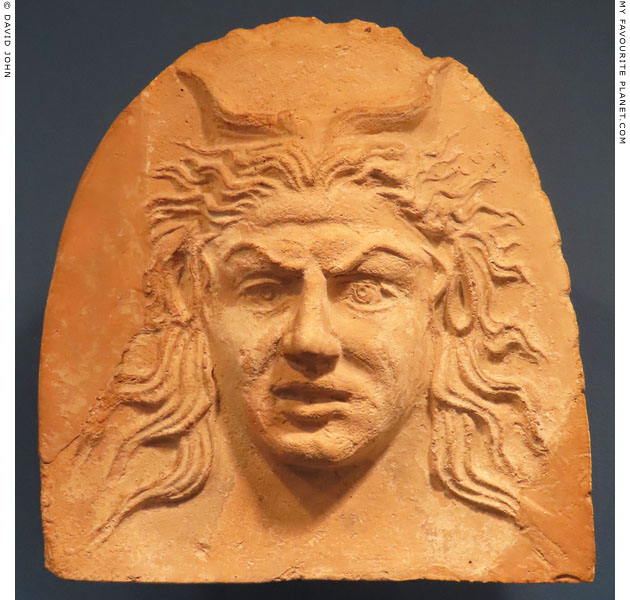
A similar terracotta antefix with an almost identical head of Pan (made from the same
mould?). The bottom right hand corner and part of the right side have been restored.
From Taranto. Hellenistic period.
Allard Pierson Museum, Amsterdam. |
| |
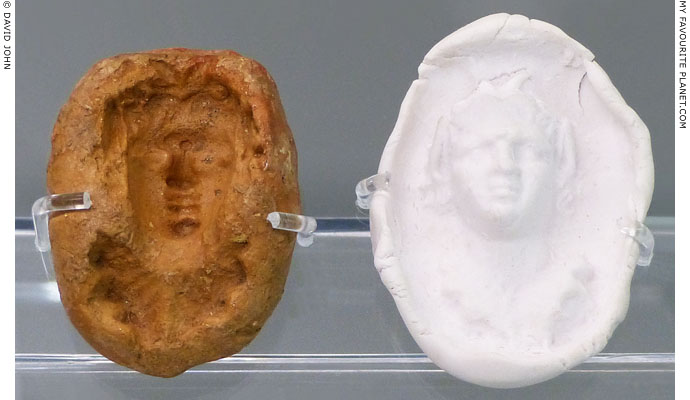
A terracotta mould of Pan's head (left), and a modern plaster cast made from it.
From Piraeus. 350-300 BC.
Piraeus Archaeological Museum. |
| |
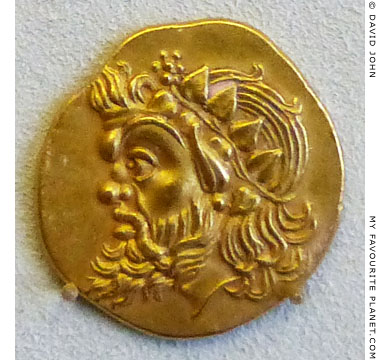 |
|
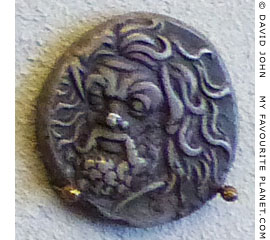 |
A gold stater (left) and a drachm (at the same scale) of Panticapaeum
(Παντικάπαιον, Pantikapaion; today Kerch) on the east coast of the
Crimea, with the head of Pan as a pun on the city's name. 4th century BC.
These coins and the stater from Kyzikos (below left) show Pan as an older man
with wild, dishelleved hair and beard. On the staters he wears a diadem with ivy
leaves and berries. The depiction of the god on the coins above appears comical,
cartoonish, begging the question often asked in relation to such representations
on coins, of whether the head was based on a statue type.
Numismatic Collection, Bode Museum, Berlin. |
|
| |
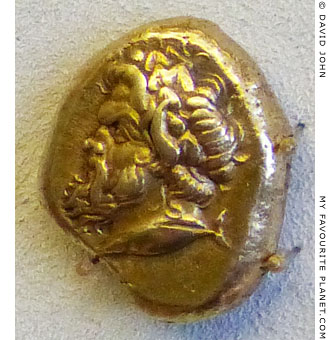 |
|
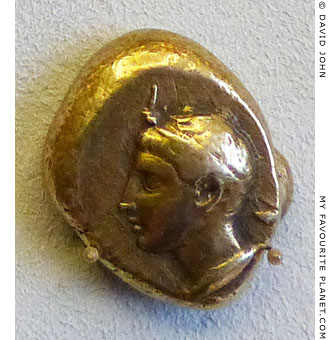 |
Staters (at the same scale) of Kyzikos (Κύζικος), Mysia
(Erdek, Turkey), with heads of Pan. Circa 400-330 BC.
As in the stater from Panticapaeum above, the coin on the left shows Pan as
a mature, bearded man. Below the head is tuna fish, the symbol of Kyzikos. On
the right he appears as a clean-shaven young man with short hair and a diadem.
Numismatic Collection, Bode Museum, Berlin. |
|
| |
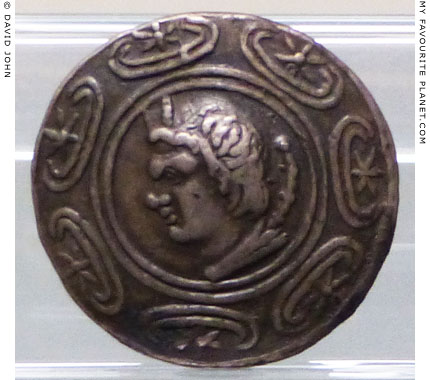
Head of Pan on a silver tetradrachm of Antigonus II Gonatas (Ἀντίγονος B΄ Γονατᾶς,
circa 319-239 BC) king of Macedon, of the Antigonid dynasty, son of Demetrios
Poliorketes. A "shield coin", minted during the second period of his reign, 272-239 BC.
Diameter 31.3 mm, weight 16.92 grams.
Civic Archaeological Museum, Milan. Inv. No. Brera, n. 1184.
|
The horned head of Pan, facing left, wearing a goat skin, with a lagobolon over his shoulder, in the centre of a Macedonian shield, decorated with seven peltai (from the Greek πέλτη, shield), each shown as a double crescent around a star. A similar design can be seen on a Ptolemaic shield model of around the same period from Memphis, Egypt, with the head of Medusa in the centre (see Medusa part 6).
The other side of the coin in the museum can not be seen, but according to the labelling the inscription reads ANTIΓONOY BAΣIΛEYΣ. Between the two words stands armed Athena Alkidemos (Ἀθῆνη Ἀλκίδημος, defender of the people, demos), the patron goddess of Pella, Macedonia, in a fighting pose similar to Athena Promachos. She is viewed from behind, advancing to the left, brandishing a thunderbolt in her raised right hand, and holding a shield decorated with the aegis on her left arm. There is a crested Macedonian helmet in inner left field. The figure is often referred to by numismatists as Athena Promachos or Athena Alkis.
Several coins of this type have survived, and are thought to have been minted at Amphipolis, Macedonia. Usually the inscription reads BAΣIΛEΩΣ ANTIΓONOY. It has been suggested that such "shield coins" were minted to commemorate specific battles, and that this Pan coin type may have originally been produced to celebrate Antigonus' victory over the Galatians at the Battle of Lysimachia in 277 BC. Macedonians attributed their victory to the intervention of Pan in a similar way to his divine assistance to the Athenians at the Battle of Marathon. [14]
A similar round Macedonian shield (without a central figurative motif) is shown on a marble relief of a battle scene on the Aemilius Paullus Monument at Delphi (around 168 BC). |
|
| |
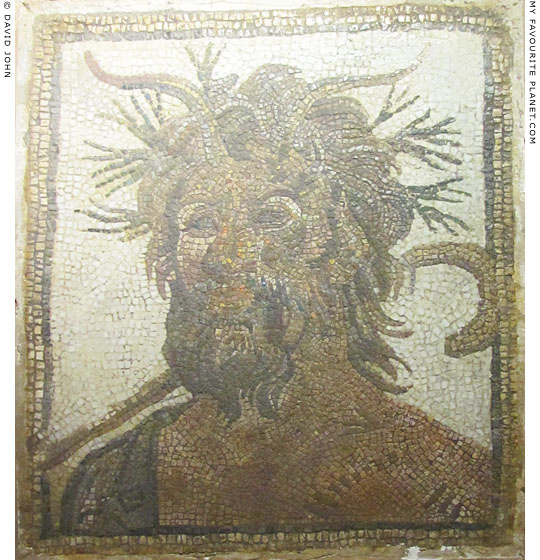
A bust of Pan with his lagobolon on a mosaic panel.
Hellenistic. From Panormos, Mysia (Bandirma,
northwestern Turkey). Height 73 cm, width 62 cm.
Istanbul Archaeological Museum. Inv. No. 1608. |
| |

Dancing Pan with his lagobolon and animal skin cloak.
Detail from a Roman Period floor mosaic from Ephesus depicting
the myth of Dionysus discovering the sleeping Ariadne on Naxos.
Izmir Archaeological Museum, Turkey.
See more information about this mosaic on Selçuk gallery 2. |
| |
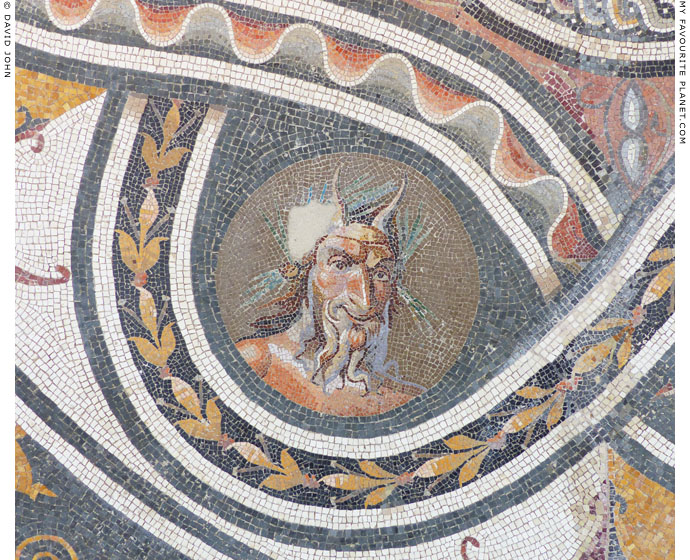
Mosaic panel with a bust of Pan.
Reign of Antinonus Pius (138-161 AD). Found in a Roman villa in Genazzano.
Part of a large highly-detailed floor mosaic with a complex illusionistic geometric pattern,
which contained seven roundels with images, only two of which have survived. The other
roundel shows a satyr, and the central panel may have featured a bust of Dionysus.
Palazzo Massimo alle Terme, National Museum of Rome. |
| |
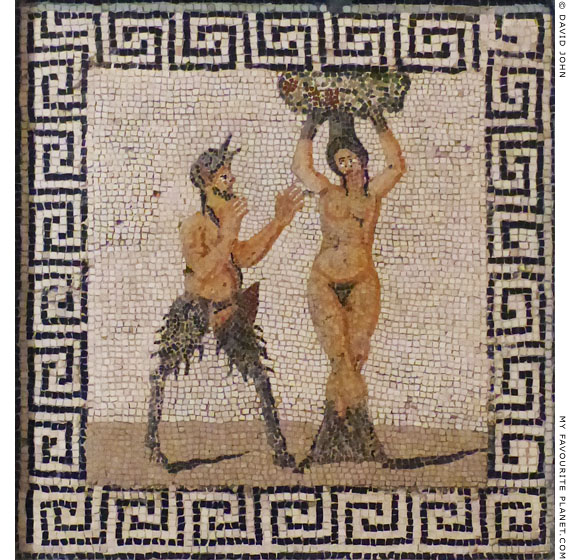
Small mosaic panel with Pan and the Nymph Pitys or a Hamadryad (tree Nymph).
Supposedly from Pompeii, although it has been suggested that it is a modern
forgery and that it is not from the Farnese Collection. 25 x 27 cm.
National Archaeological Museum, Naples. Inv. No. 27708
(The museum label incorrectly states 227708). From the Farnese Collection.
|
Pan lusted after the Nymph Pitys (Πίτυς, pine) and chased her, until Boreas (Βορέας), the god of the north wind, transformed her into a pine tree to protect her. The Hamadryads (Ἁμαδρυάδες) were dryads (a type of Nymph) who lived in trees. The excited god appears either surprised to find that his quarry has escaped him, or delighted to discover such a voluptuous tree.
So far I have found no scholarly discussion concerning the authenticity or otherwise of this mosaic, or of its history. It is known to have been in the collection of the Duke Carafa of Noja (the Noja Collection) in Naples, then passed into the Farnese Collection, much of which now forms the inventory of the Naples Museum. It was displayed for many years in the Gabinetto segreto (Secret Cabinet), the museum's small department of "obscene" ancient objects, and was mentioned briefly and without comment in some guide books [15].
The mosaic has since been considered safe enough, at least in terms of its imagery – evidently no longer seen as "obscene" or "pornographic" by today's standards – to be moved from the dark corner of the Cabinet into the main rooms of the museum. It is now exhibited among the ancient mosaics excavated at Pompeii (including the "Alexander Mosaic"), Herculaneum and other sites in Campania, which have a certain provenance. Its museum label merely states: "Pan ed Amadriade. Collezione Farnese". However, the information board at the entrance to the Gabinetto segreto, presumably written when the mosaic was still there, hints that the work may not be kosher when describing the Cabinet's history:
"Statues, items of jewellery, oil lamps and miniature paintings adorned with erotic subjects were prized by aristocratic collectors; they were a source of artistic inspiration, fake reproductions (mosaic with Pan and nymph: inv. 27708), literary erudition – clarifying ancient authors' allusions to sensuality – or simply prurient curiosity."
A 16th century book illustration by Giulio Bonasone (see below), appears to provide evidence that the mosaic is a modern (i.e. after the mid 15th century) fake or reproduction. The image is from Achille Bocchi's Symbolicarum quaestionum de Universo genere quas serio ludebat, published in Bologna in 1574. Many of the illustrations in the book feature figures evidently copied from the recently discovered ancient works of art that decorated the houses of aristocrats and top clergymen in Italy from the early Renaissance, notably sculptures of Minerva (Athena) and Hercules (Herakles). The last illustration in the volume, number 150, shows a scene almost identical to the mosaic. There are several differences, including the twisting of the bottom of the Nymph/tree, the appearance of a blowing Boreas in the top right corner and the background landscape with a fortified settlement. These may be additions of Bonasone's imagination. If the mosaic is a "reproduction", what did it reproduce? Is the illustration a copy of the mosaic or some other (unknown) work, or was the mosaic a forgery copied from this print or a similar (contemporary) drawing?
A small part of the long buried and forgotten ancient city of Pompeii was uncovered by chance during the construction of a water channel from the river Sarno in 1599, twenty five years after the the publication of the book. At the time it was not realized that this was the location of Pompeii, the finds there did not excite much interest and excavations only began in 1748, following the rich discoveries at Herculaneum. However, it is known that "graverobbers" had been active in the area some time before, and several ancient artefacts had found their way on to the art market.
One wonders if the work has been studied or analyzed in recent years. Mosaics are difficult to date since they are made of inorganic materials and the techniques and tools used by mosaic makers have not changed significantly since antiquity. There still may be clues to be found from the materials used for the tesserae or how they were worked and cut, or the composition of the cement. The evidence provided by the image itself, its composition, Pan's disproportionately large hands, the "modern" looking female form and the clumsy meander border, may be more difficult to evaluate, as many genuine ancient mosaics were (and still are) badly restored, sometimes resulting in the complete destruction of the nature of the original image.
If the work is a fake, should it remain among the ancient mosaics without some kind of notice? And if there is a chance that it may be ancient, why has it not been subjected to a scholarly examination? |
|
| |
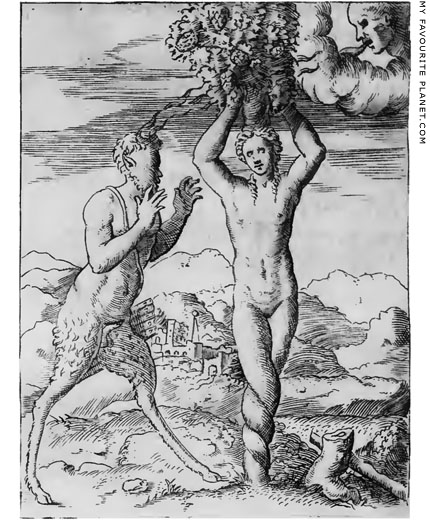
Pan and Hamadryad or Pitys in a 16th century book
illustration by Giulio Bonasone (circa 1498-1580).
Source: Achille Bocchi (1488–1562), Symbolicarum quaestionum
de Universo genere quas serio ludebat, Book 5, plate 150, page 354.
Società Tipografica bolognese, Bologna, 1574. At the Internet Archive. |
| |
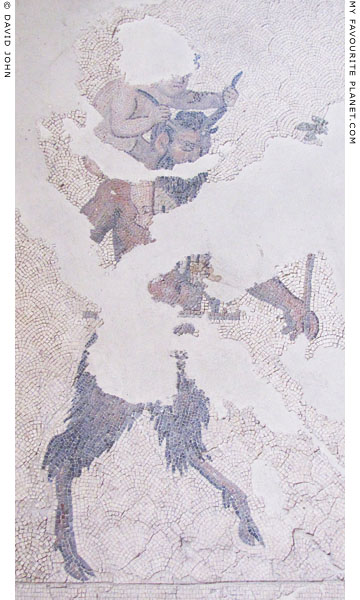
Part of a floor mosaic showing Pan carrying
the infant Dionysus on his shoulders.
In situ on the site of a peristyle courtyard of the the Byzantine Great Palace
(Palatium Magnum), of Constantinople. Late 6th or early 7th century AD.
Great Palace Mosaic Museum, Istanbul.
|
| The fragmentary section of the enormous 170-180 square metre floor mosaic is thought to be part of a depiction of Dionysus' triumphal procession from India, known from several other ancient artworks (see the Dionysus page). Unusually, the infant Dionysus is shown being carried by Pan. He holds on to the horns of the goat-footed god, who carries a lagobolon in his left hand, and perhaps a syrinx in the right. Part of an elephant ridden by a man is shown following them. |
|
| |
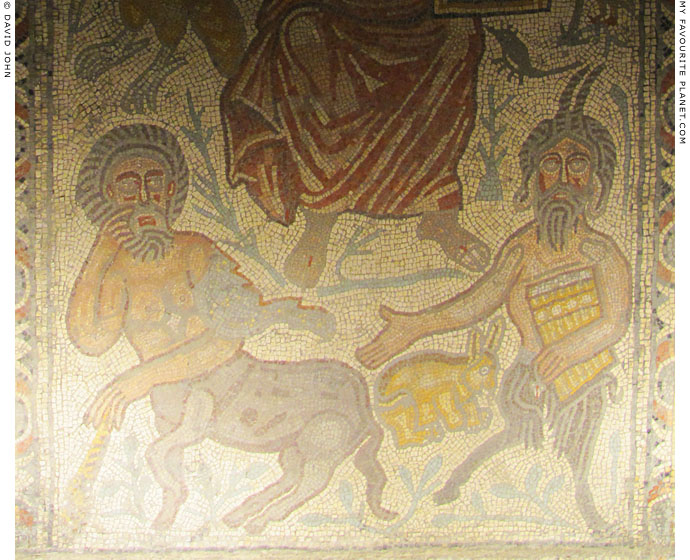
Part of a floor mosaic showing a centaur and Pan with his syrinx.
From Jerusalem. Late 5th - early 6th century AD.
Detail of the central panel from a large floor mosaic depicting Orpheus.
The mosaic artist is thought to have used the image of Orpheus and
other figures and elements from earlier pagan iconography to convey
Christian concepts such as the "immortality of the spirit".
Istanbul Archaeological Museum. Inv. No. 1642 T. Cat. Mendel 1306. |
| |
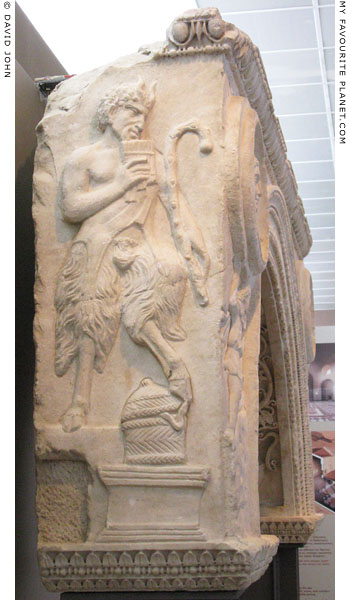 |
|
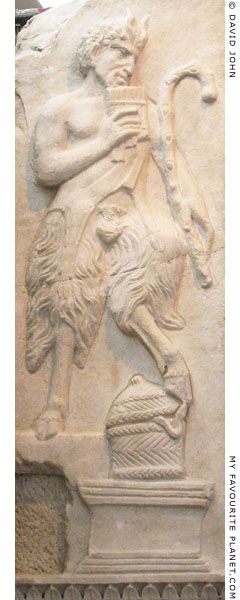 |
Relief of Pan on the left side of the "Little Arch of Galerius" in Thessaloniki.
Imperial workshop, Thessaloniki, circa 308-311 AD. See below.
Pan dances while playing his syrinx. In his left hand he holds his lagobolon.
His left foot rests on the lid of a basket (standing on a low base or altar) from
which a snake is emerging. The basket has been interpreted as the cista mystica
(sacred kiste), and Pan is shown in this pose in several depictions of him, usually
in assocation with Dionysian scenes, particularly the Triumph of Dionysus. Thessaloniki Archaeological Museum. |
|
| |
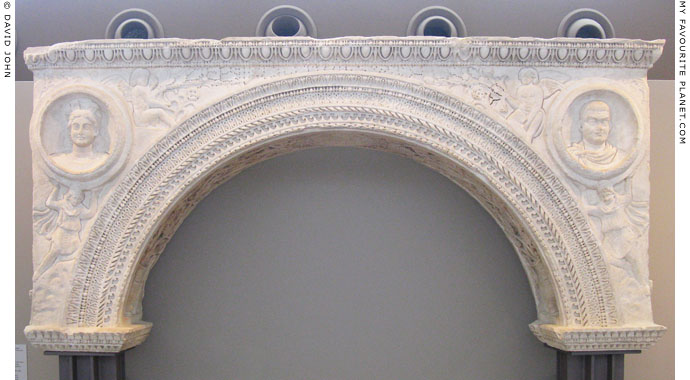
The front of the "Little Arch of Galerius" (Μικρό τόξο Γαλερίου).
Found in 1957, south of the Octagon, central Thessaloniki.
The arch is known as the "Little Arch of Galerius" to disinguish it from the larger
triumphal Arch of Galerius which stands on the Odos Egnatia, central Thessaloniki.
Sculpted from a single marble block, it was part of a small temple of the palace of
Emperor Galerius. The decorative reliefs include medals with portraits of Galerius
and his wife Augusta Galeria Valeria, supported by figures of eastern subjects
(perhaps Persians). Between the medals two winged erotes (cupids) hold a
garland. On the right side is a Nymph, and on the intrados (inside of the arch)
a medal with a head of Dionysus.
Thessaloniki Archaeological Museum. Inv. no. ΜΘ 2466. |
| |
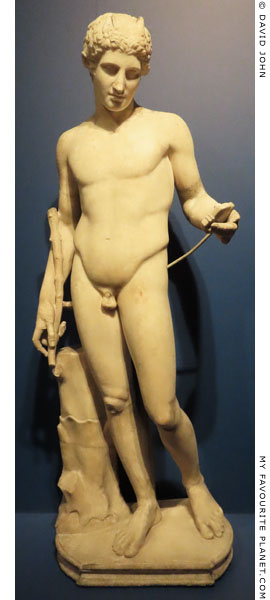 |
|
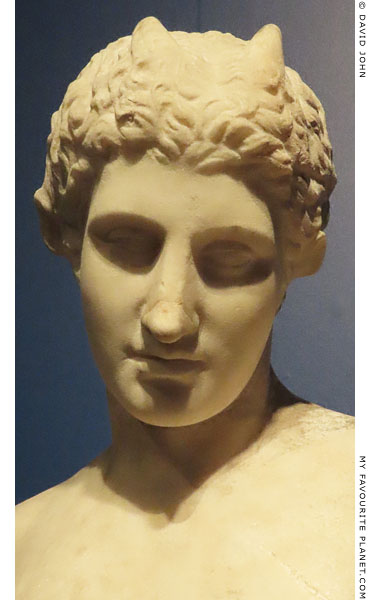 |
A much-restored marble statue of a youthful, beardless Pan, with horns and
pointed ears, holding a syrinx in his left hand, and a lagobolon in the right hand.
Late Hellenistic or Roman Imperial period. From Italy. One of six
surviving sculptures of a type thought to be copies of an original
by Polykleitos the Elder or his school. Height 109.8 cm.
Rijksmuseum van Oudheden, Leiden, Netherlands. Inv. No. Pb 98.
From the Papenbroek Collection. Bequeathed by
Gerard van Papenbroek (1673-1743) to Leiden University. |
|
| |
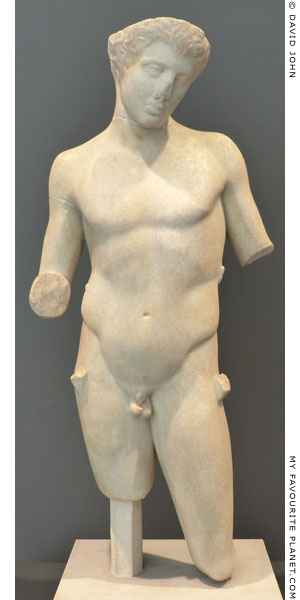 |
|
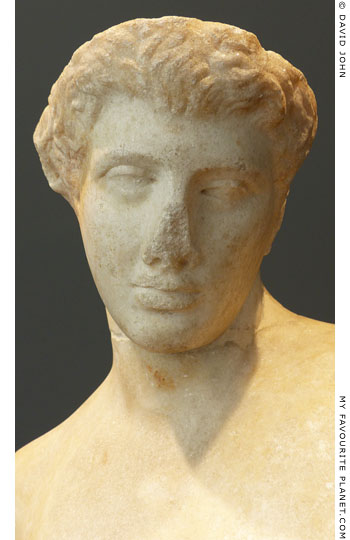 |
Marble statue of a pensive-looking Pan.
The top of the head is missing as well as both forearms, the right leg from
the thigh and the left leg below the knee. Statues of this type usually show
Pan holding a syrinx in the left hand and a lagobolon in the right.
Medium-grained white Greek marble. Early Roman Imperial period
copy of a Hellenistic Classicistic original. Found in 1902 in the remains
of a large residence in the Via Tasso, Rome. Height 75 cm.
Palazzo Massimo alle Terme, National Museum of Rome. Inv. No. 52389. [16] |
|
| |
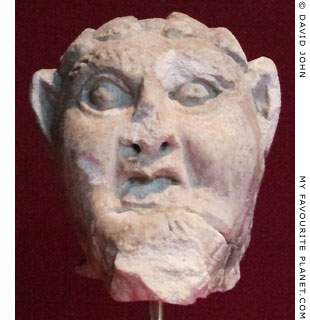
A marble head of Pan.
Roman period. Found in 2004 in the Agora
of Smyrna (Izmir, Turkey). Height 16 cm,
width 13 cm, depth 9 cm.
Department of Sculpture,
Izmir Museum of History and Art.
Inv. No. 022.618. |
|
|
|
| |
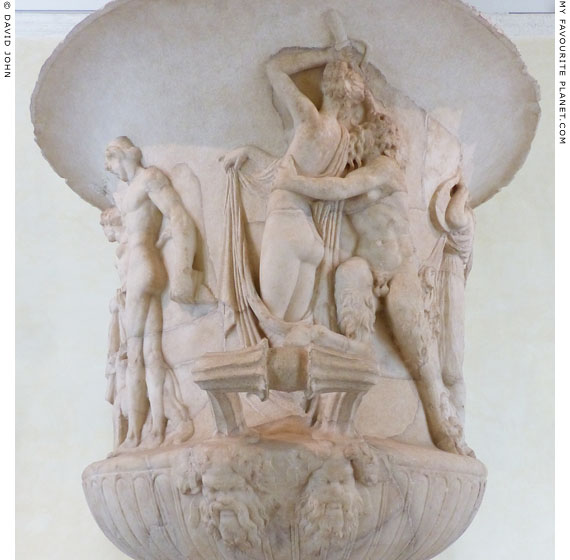
Pan and a maenad at erotic play. Detail of a large marble krater with reliefs of Bacchic scenes.
Pentelic marble. Found in 1872 in the Horti Vettiani, Rome.
Palazzo dei Conservatori, Capitoline Museums, Rome. Inv. No. MC 1202. |
| |
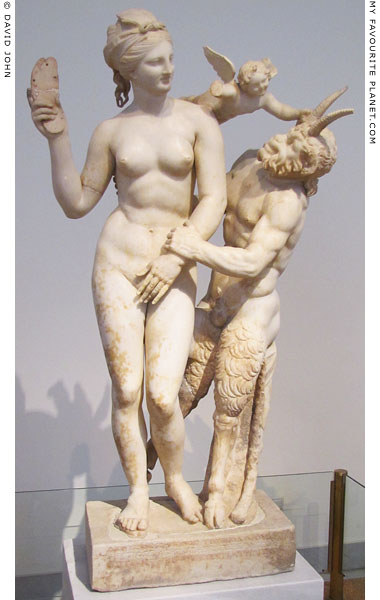 |
|
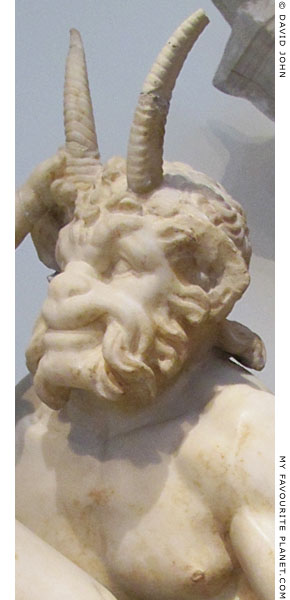 |
Marble statue group of Aphrodite, Eros and Pan. Right, a close-up of Pan from the group.
Parian marble. Circa 100 BC. Height 129 cm, including base 155 cm.
Found in 1904 in the "House of the Poseidoniastai of Beryttos" (a guild of
worshippers of the god Poseidon from Beirut), Delos, Greece. The inscription
on the base is a dedication by Dionysos of Beryttos to his ancestoral gods:
"Dionysos, son of Zenon who was son Theodoros, from Beryttos dedicated
[this offering] to the ancestral gods for his own benefit and that of his children."
The nude Aphrodite fends off the erotic advances of the goat-footed Pan, and
threatens him with her sandal. A tiny winged Eros tries to assist the goddess by
holding onto Pan's right horn. All three figures appear to be smiling, and the tone
of the work is playful. Pan's face has been given remarkable goat-like features.
His lagobolon rests against the tree stump which also supports his left leg.
National Archaeological Museum, Athens. Inv. No. 3335. |
|
| |
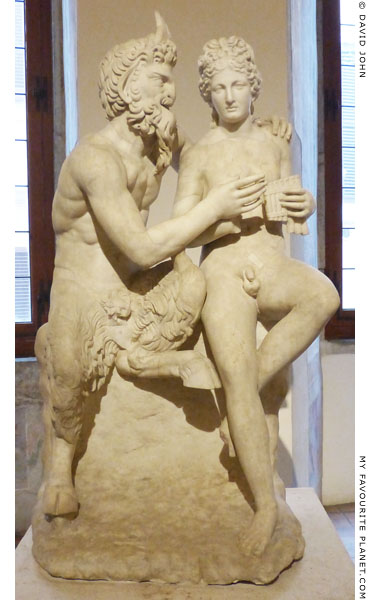 |
|
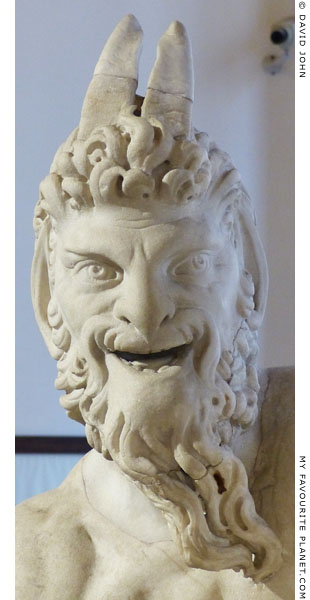 |
Heavily restored marble statue group of Pan and Daphnis.
Roman period, perhaps a copy of a Hellenistic marble original by
Heliodoros of Rhodes, around 100 BC. Coarse-grained crystalline marble.
An erotic scene of Pan teaching the young shepherd Daphnis to play
the syrinx. Probably designed to decorate a garden. Both heads and
Daphnis' right arm are 18th century restorations. Height 132 cm.
Palazzo Altemps, National Museum of Rome. Inv. No. 8571.
Boncompagni Ludovisi Collection, from the Cesi Collection.
Purchased by the Italian government in 1901.
|
|
The mortal shepherd Daphnis (Δάφνις) was said to have lived in Sicily, although some ancient authors wrote that he was from Crete or other places. He was either the son or lover (eromenos) of Hermes, and his mother was a Nymph. He was credited with the invention of bucolic (pastoral) poetry.
Other similar marble statue groups of Pan and Daphnis have been dated from the late Hellenistic to early Imperial period. All were found in Italy, and have been restored. They include:
Pan "teaching Olympos to play the syrinx". An Antonine period copy. National Archaeological Museum, Naples. Inv. No. 6329. From the Farnese Collection. Height 158 cm.
Uffizi Gallery, Florence. Inv. No. 92. From the Cesi Collection. Parian marble. Height 140 cm.
Statue of Daphnis, seated and holding a syrinx. Uffizi Gallery, Florence. Inv. No. 253. From the Valle Collection. Parian marble. Height 129 cm.
"Pan and Apollo (or Marsyas and Olympos or Pan and Daphnis). Roman statue of late Greek type, of Pan teaching Olympos (or Daphnis), the blind shepherd boy to play Pan's invention, the syrinx (reed pipes arranged in a row of ascending length), both seated on a rock over which is spread a lion skin. Olympos (Daphnis) restored with an antique head, probably originally of Dionysos." Petworth House, Sussex, England. Inv. No. NT 486318. From the Wyndham Collection. Found in Rome around 1726, and restored by Pietro Pacilli (1716-1772) and Vincenzo Pacetti (circa 1745-1820). Height 146.5 cm, width 95.5 cm, depth 56.3 cm. See: nationaltrustcollections.org.uk/object/486318
The type has been considered by some scholars to be copied from the "Olympus and Pan" (Latin, "olympum et pana") mentioned by Pliny the Elder. The highly-valued marble sculpture by an unknown artist stood in the porticos of the Septa in the Campus Martius, Rome.
"No less is the uncertainty that prevails as to the authors of the statues now to be seen in the Septa; an Olympus and Pan, and a Chiron and Achilles ["chironem cum achille", see Homer part 2]; and yet their high reputation has caused them to be deemed valuable enough for their keepers to be made answerable for their safety at the cost of their lives."
Pliny the Elder, Natural History, Book 36, chapter 4. At Perseus Digital Library.
In Greek myth, Olympos (Ὄλυμπος), after whom Mount Olympus in Mysia, northwestern Anatolia, was named, was a poet, a player on the aulos (pipes, often referred to as "flute") and disciple of the Satyr Marsyas. Later in the same chapter, Pliny mentioned a marble statue group of Pan and Olympus (pana et olympum) wrestling by Heliodorus (perhaps Heliodoros of Rhodes), which stood in the Porticus Octaviae (Portico of Octavia), Rome.
"The figures of Pan and Olympus Wrestling, in the same place, are by Heliodorus; and they are considered to be the next finest group of this nature in all the world." [17]
Pliny the Elder, Natural History, Book 36, chapter 4. At Perseus Digital Library. |
|
| |
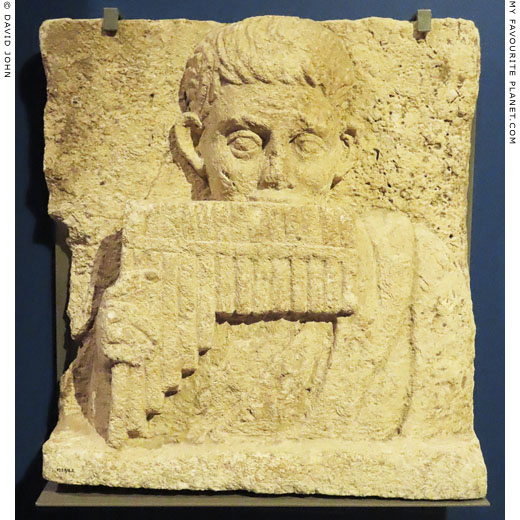
A limestone relief of a boy in Roman dress playing a syrinx (Pan pipes) with 14 pipes.
3rd century AD. From Oxyrhynchos (Ὀξύρρυγχος, today Al Bahnasa), Middle Egypt.
Said to be from the temple of Serapis. Height 56 cm, width 52 cm, depth 10.8 cm.
Rijksmuseum van Oudheden, Leiden, Netherlands. Inv. No. F 1959/8.2. |
| |
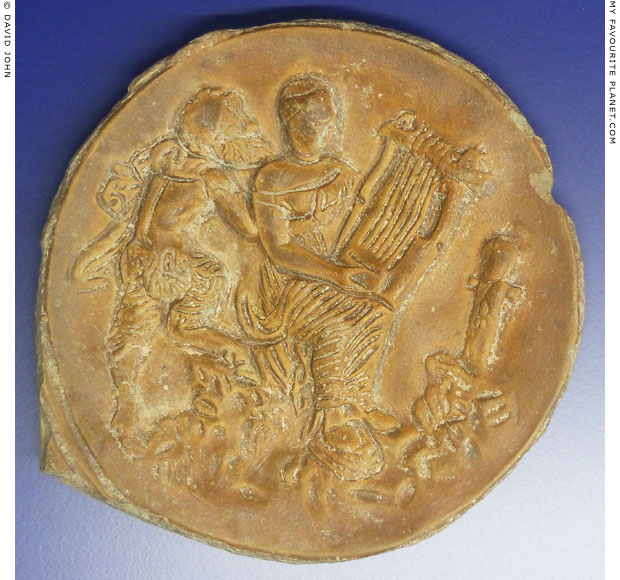
The bottom of a terracotta relief bowl with a depiction of Pan groping a Nymph
as she sits on a rock playing a lyre. To the right, a herm stands on a rock.
From Egypt, probably 1st century BC.
Museum für Kunst und Gewerbe Hamburg. Inv. No. 1941.2. |
| |
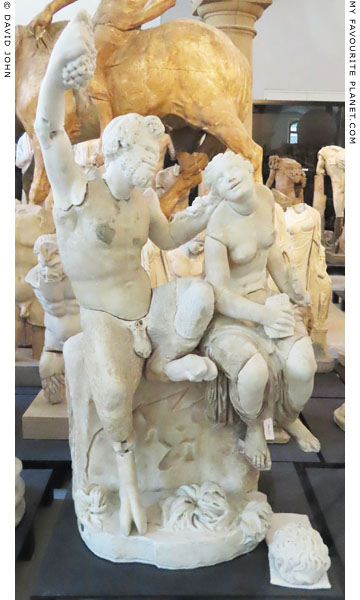
"Pan and a Nymph", a marble statue group of Pan,
holding a bunch of grapes in his raised right hand,
seated on a rock with a Nymph (or Maenad), who
is holding a syrinx (Pan pipes) in her right hand.
Early Roman Imperial period, extensively restored in
Rome in the late 17th or early 18th century, with the
addition of 23 non-related parts, ancient and modern.
Purchased in Rome in 1728 for the royal art collections
in Dresden from the collection of Fabrizio Naro. In 1894
it was taken apart, the non-related parts were removed
and it was reassembled with other ancient sculpture
fragments in the Dresden collection. In 2009 it was once
more restored, returning it to its Baroque appearance.
Today the work resembles other ancient groups
depicting Pan and Daphnis and Pan with a Nymph
(see above), as well as a 2nd century BC statue group
known as "Invitation to dance" (German, "Aufforderung
zum Tanz"). Height 161 cm, width 90 cm, depth 68 cm.
Skulpturensammlung, Albertinum, Dresden.
Inv. Nr. H4 061 / 034.
Currently (2023) displayed in the "Gläsernes Depot"
alongside several ancient sculptures and modern copies. |
|
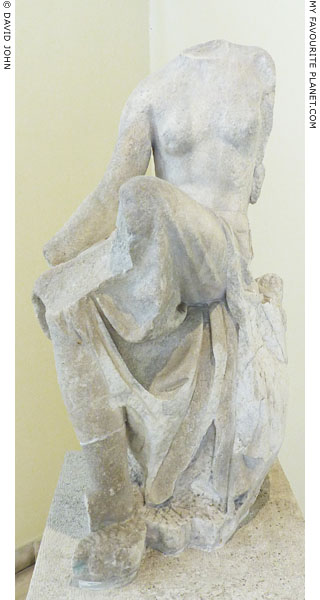
A marble statue of a Nymph (or Maenad)
sitting on a rock. A 2nd century AD copy
of the "Invitation to dance" statue group.
Piraeus Archaeological Museum.
Inv. No. 1169 + 1362. |
|
| |
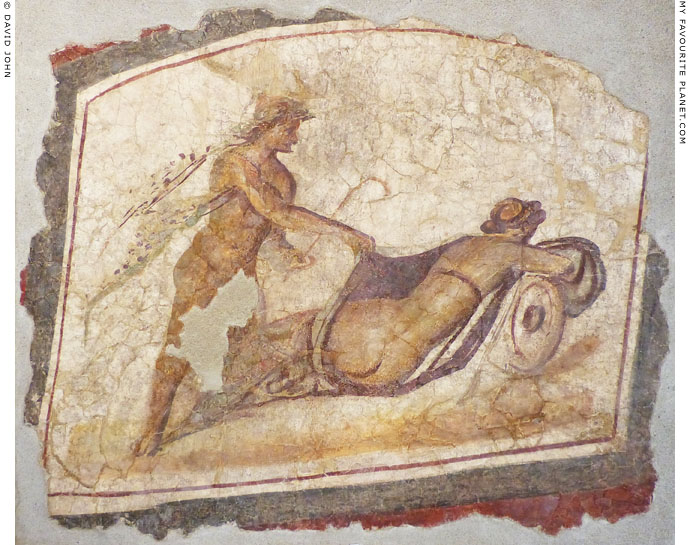
A Roman fresco in Rome labelled "Fresco with Pan and Maenad".
Painted plaster, 193-211 AD.
Antiquarium Communale, Capitoline Museums, Rome.
|
One of several frescos, depicting domestic, rustic and mildly erotic scenes, found in private houses near the Via Nationale in Rome. In this painting a nude male figure wearing a garlanded helmet uncovers a sleeping woman. He does not appear to have horns, and the legs and feet are so crudely drawn that it is difficult to tell whether they are human or goat. The only other indication that he may be the rustic deity is the lagobolon (a crook and hunting stick for throwing at hares) he carries.
The scene is reminiscent of depictions of Dionysus, with Pan and other members of his thiasos, discovering the sleeping Ariadne on Naxos (see Selçuk gallery 2, page 2). Perhaps this artist was wittily putting the male viewer in Dionysus' shoes. On the other hand the sleeping figure may be Hermaphroditus. The alluring subject of the naked sleeping maenad or sleeping Hermaphroditus, viewed from behind, was common during Roman times, and such statues were placed in the men's section of public baths. |
|
| |
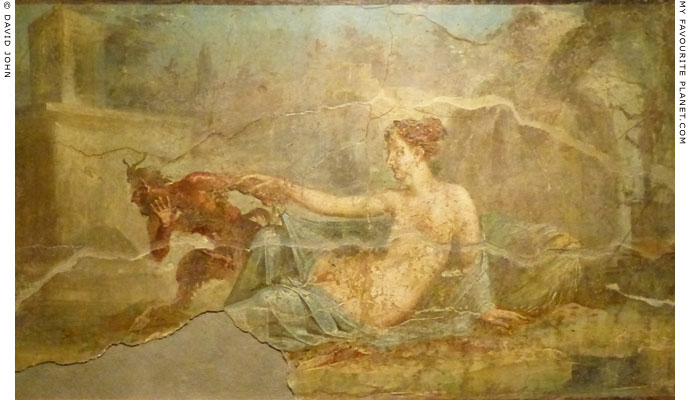
Fresco with Pan and Hermaphroditus.
From the atrium of the House of the Dioscuri (Casa dei
Dioscuri, Regio VI, Insula 9, Casa 6), Pompeii. 1-50 AD.
National Archaeological Museum, Naples. Inv. No. 27700. Secret Cabinet.
|
| Although several Roman artworks show Hermaphroditus defending herself from erotic advances of Satyrs, here the tables have been turned. It appears that the goat-footed god Pan, shown in other scenes sexually drawn to Aphrodite and even goats (see below), is here trying to escape from Hermaphroditus' grasp. The signal he sends with his turned head and raised right hand says it all. |
|
| |
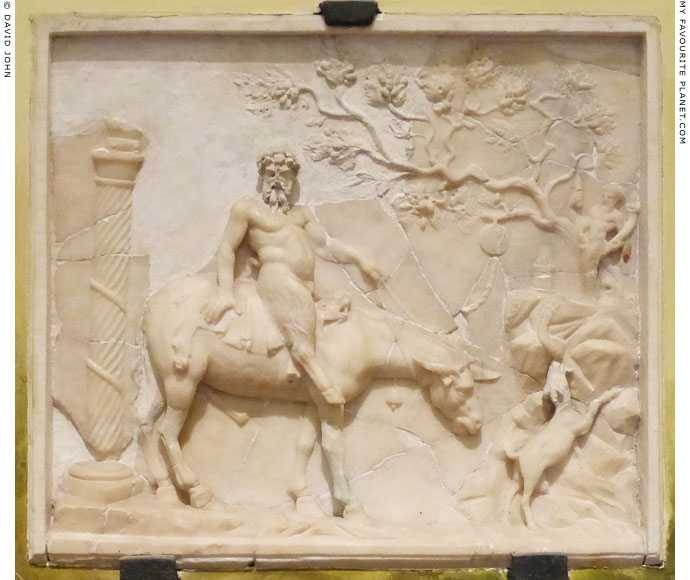
Erotic marble relief of Pan, riding an ithyphallic mule, approaching a hillside shrine.
From Pompeii. Roman copy of a late Hellenistic original.
National Archaeological Museum, Naples. Inv. No. 27712. Secret Cabinet. |
| |
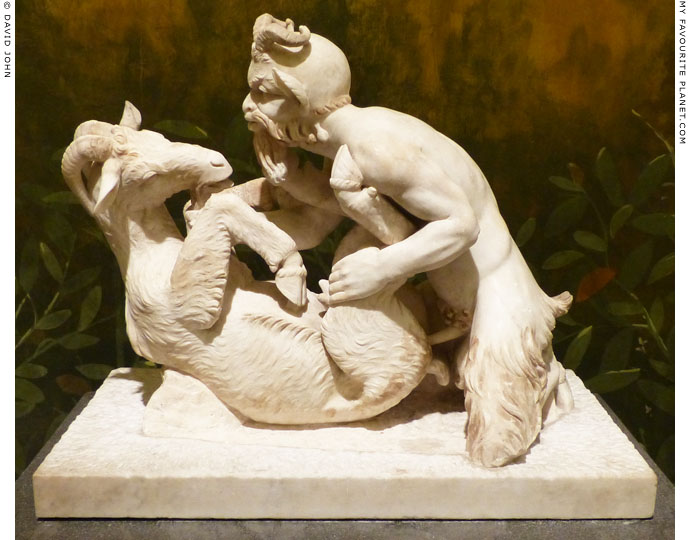
Marble statue group of Pan copulating with a goat.
Found in the Grand Peristyle of the Villa of the Papyri, Herculaneum, during
excavations in 1752. 1st century BC - 1st century AD, thought to be a copy
of a Hellenistic original. Height 44.2 cm, width 47.5 cm. Following its discovery,
the sculpture was considered so shocking that it was locked away in a cupboard
for many years and only the king of Naples was allowed to see it.
A Silen is shown in the same way in a relief on a Roman period marble sarcophagus,
circa 210 AD, now in Dresden, depicting a Dionysian scene (see Dionysus).
National Archaeological Museum, Naples. Inv. No. 27709. Secret Cabinet. |
| |
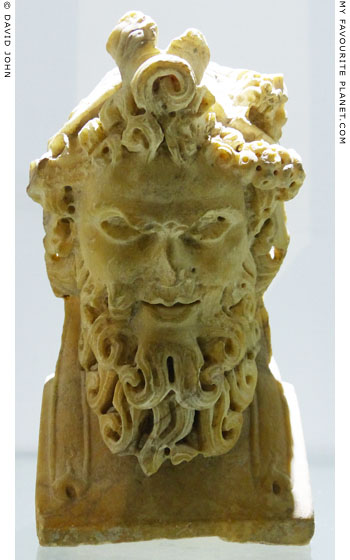
Marble bust of Pan in the form of the top of a herm.
From Contrada Verdura-Fusillo (Ribera), Sicily. Roman period.
Agrigento Regional Archaeological Museum, Sicily. |
| |
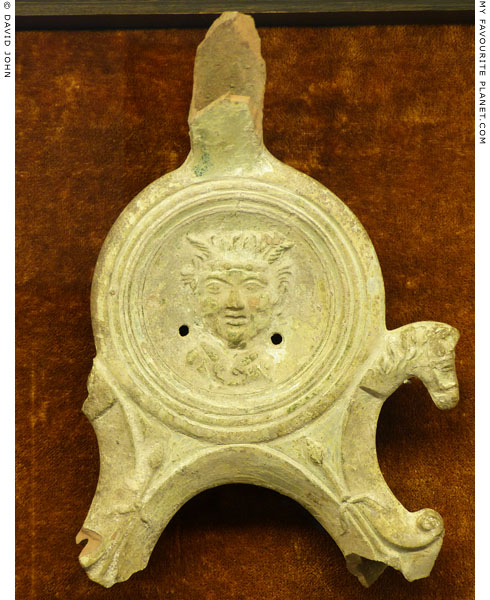
Fragment of a double ceramic lamp with a double
burner (bilycne) from Pompeii with the head of Pan.
National Archaeological Museum, Naples. |
| |
The dedication of terracotta lamps at sanctuaries of Pan appears to have begun in the 3rd century BC, and thereafter became increasingly popular, particularly at Greek cave sanctuaries, in which they were among the most frequent dedications. The fashion may have been a concrete form of a much more ancient ritual practice, perhaps connected with the use of torches in the nocturnal rites of Pan.
"... at Phyle on Parnes, most notably, they were so numerous that they gave the cave its modern name, Lichnospilo; cf. also Vari, where more than a thousand lamps were found (AJA 7, 1903, pages 338-349)."
Philippe Borgeaud, The cult of Pan in ancient Greece, pages 220-221, note 7. Translated by Kathleen Atlass and James Redfield. The University of Chicago Press, 1988. |
|
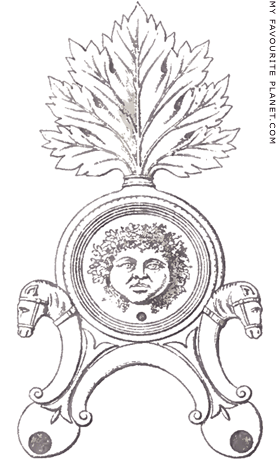
A Gorgoneion on a similar double
ceramic oil lamp from Pompeii.
National Archaeological Museum, Naples.
Source: Domenico Monaco and Eustace
Neville Rolfe, Specimens from the
Naples Museum, page 48 and
plate 62. William Clowes & Sons,
London, 1884. At the Internet Archive. |
|
| |
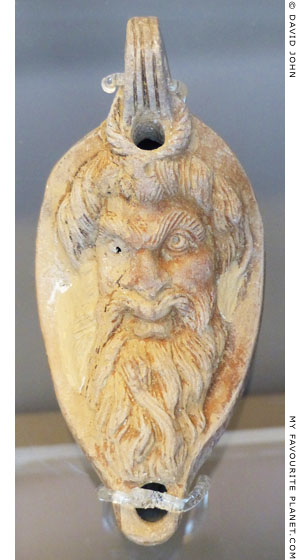
The head of Pan on a ceramic oil lamp.
Roman period. Exhibited in a group
of oil lamps from the area of Elis,
western Peloponnese, labelled simply:
"Lamps. Epitalion and Kaukania.
1st c. BC - 3rd c. AD."
Pyrgos Archaeological Museum. |
|
|
| |
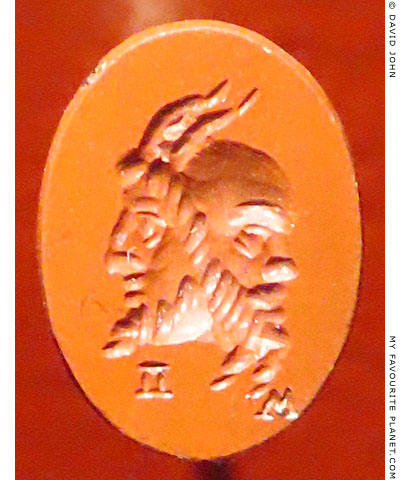
A carnelian gem engraved with the faces of Pan and the Satyr
Marsyas, shown back-to-back. The initial letters of their names
in Greek, Π and Μ, are inscribed below their respective beards.
Roman period, 1st - 2nd century AD. From Egypt.
Allard Pierson Museum, Amsterdam. Inv. No. 7911. |
| |
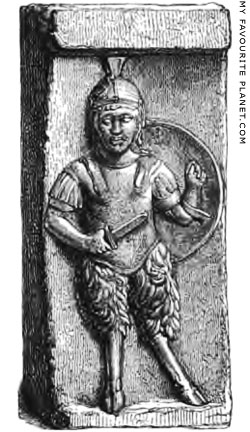
A small marble altar with a relief of Pan as a warrior.
Roman period, 1st - 2nd century AD. Discovered by
John Turtle Wood in 1869, near the Temple of Artemis,
Ephesus. Height 53 cm, width 24.13 cm.
British Museum. Inv. No. 1872,0405.10 (Sculpture No. 1270). Not on display.
|
This very unusual relief depicts Pan with a beardless human face and goat's legs, wearing armour (helmet, cuirass) and holding a round shield and a short sword. The small altar was discovered by John Turtle Wood in November 1869 while excavating around the Temple of Artemis, Ephesus. On the back is a crested snake; on the left side is a bucranium (bull's skull) surrounded by an olive wreath beneath rosettes; the right side has a snake, "roughly blocked out" (A. H. Smith) or partly erased.
Tentatively dated to 1st - 2nd century AD, the altar appears similar to the type of altars and votive offerings of Roman soldiers around the empire.
John Turtle Wood, Discoveries at Ephesus, page 153. Longmans, Green and Co., London, 1877.
A. H. Smith, A Catalogue of Sculpture in the Department of Greek and Roman Antiquities, British Museum Volume 2. British Museum, London, 1906. |
|
| |
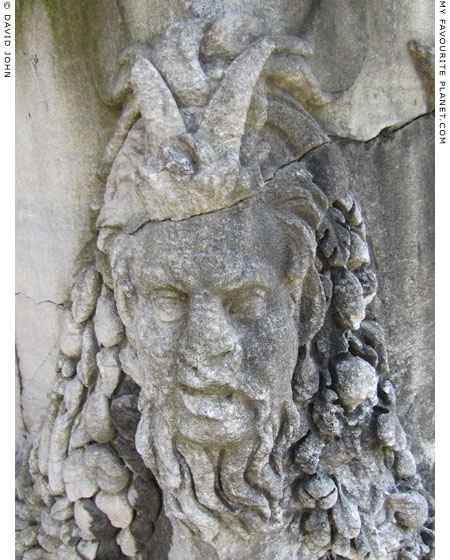
Relief of a head of Pan on the corner of a sarcophagus.
Roman Imperial period, 2nd century AD.
The large marble sarcophgaus is decorated all around with reliefs of
garlands supported by Erotes (figures of Eros), Gorgoneions (heads
of the Gorgon Medusa), and a head of Pan at each corner.
See photos of the sarcophagus in Medusa part 5.
In the courtyard of the Istanbul Archaeological Museum. Inv. No. 513. |
| |
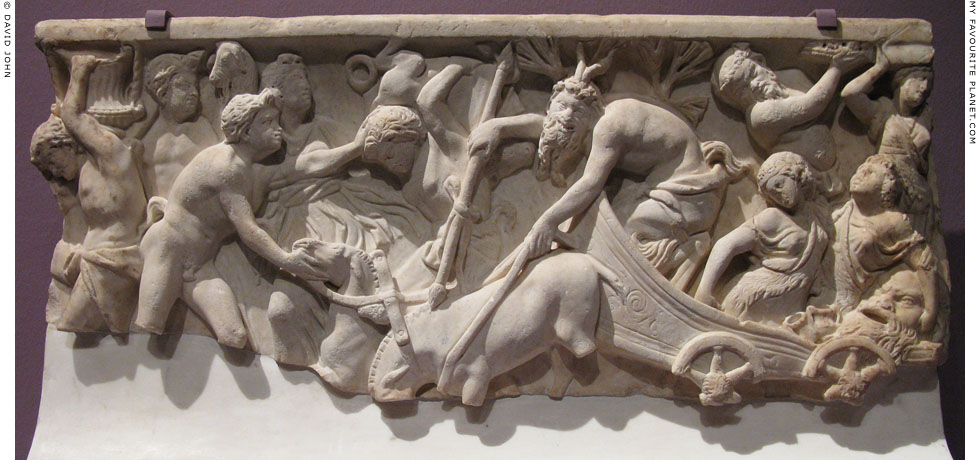
A fragment of a marble pseudo-sarcophagus with a relief of Pan driving a wagon
drawn by donkeys, among satyrs and maenads in a Dionysian procession.
Circa 150 AD. Height (not including modern base) 37 cm, width 92 cm, depth 7.5 cm.
Antikensammlung, Berlin State Museums (SMB). Inv. No. Sk 851.
Purchased in Rome in 1846 by Eduard Gerhard von Vescovali.
|
Considered one of the finest and most detailed reliefs of a Dionysian procession. The festive group moves from right to left on their way to a sacrificial rite for Dionysus. Typically, the scene is full of energy and movement, almost chaotic, with all the participants in an ecstatic and/or inebriated state.
Pan, grinning wildly towards the viewer, drives a four-wheeled wagon in the shape of a ship, with lion heads on the wheel hubs. The two donkeys, depicted at a smaller scale to the other figures, appear to be collapsing under the strain of pulling the wagon. Pan bends forward to goad one of them with a thyrsos, while a naked young satyr in front of the wagon places his right hand beneath the head of the other, and with his left hand pushes the head of a satyr carrying a calf on his back.
In the wagon are two maenads, each wearing a short chiton, a nebris and wreath of vine or ivy, with a colossal mask of Silenos and two kantharoi (wine cups). Behind them a Silen holds high a bowl of fruit, and a maenad, also in chiton and nebris, carries a basket on her head. On the left of the frieze, a young satyr carries a large krater on his shoulder, another carries a goat and a maenad holds up a bowl. It is thought that the missing right side of the relief depicted Dionysus sitting in a chariot pulled by centaurs.
See further information about Dionysian processions on the Dionysus page. |
|
| |
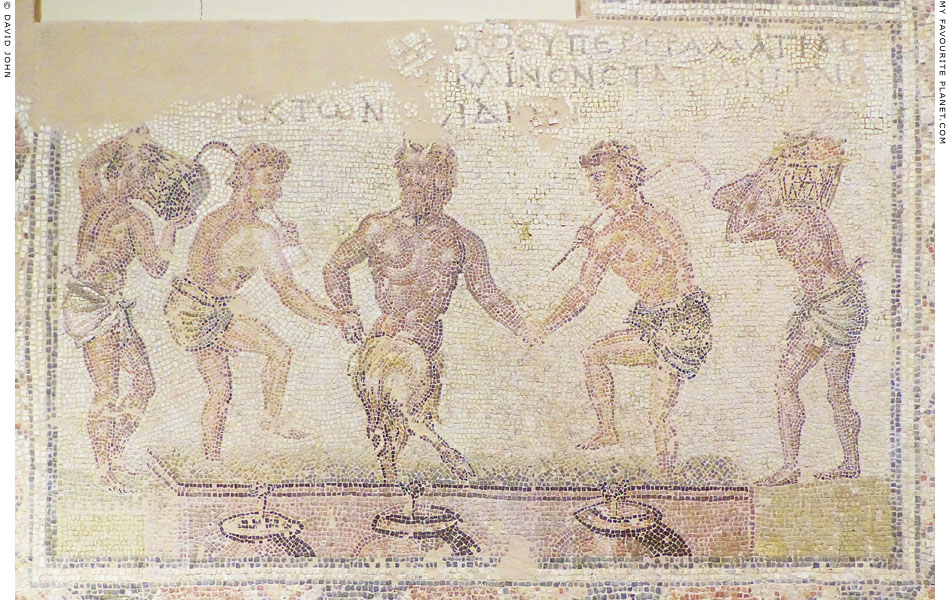
A large emblema (panel) from a floor mosaic with a depiction of Pan treading grapes in a wine press.
3rd century AD. From a Roman building in Patras, northern Peloponnese, Greece.
Patras Archaeological Museum.
|
Pan, dark-skinned and muscular, stands in the centre of the wine press, his body facing right, his head facing forwards or slightly to the left, his right goat's foot raised. He is flanked by two young male figures (satyrs?) who are also treading grapes and facing Pan. Each of them wears a loincloth and holds a lagobolon above his shoulder. The figure to the left appears to be holding on to Pan's right wrist with his right hand. In turn, Pan appears to be holding the left wrist of the other figure with his left hand. At each end of the scene a young male wearing a loincloth brings more grapes in a container (basket?). In front of the wine press stand three pithoi into which the grape juice pours through spouts on the edge of the tank.
Above the scene is part of an inscription. Above this central emblema were three smaller emblemata, only one of which has survived: it depicts a disembodied head wearing a golden helmet. The framed image areas are surrounded by geometric decoration in red, black and white tesserae. |
|
| |
| Pan |
Notes, references and links |
 |
|
1. A good read for Pan fans:
Philippe Borgeaud, The cult of Pan in ancient Greece. Translated by Kathleen Atlass and James Redfield. The University of Chicago Press, 1988. Now available as a free PDF at academia.edu.
2. Homeric Hymn 19, to Pan
The entire hymn in English:
"[1] Muse, tell me about Pan, the dear son of Hermes, with his goat's feet and two horns – a lover of merry noise. Through wooded glades he wanders with dancing nymphs who foot it on some sheer cliff's edge, [5] calling upon Pan, the shepherd-god, long-haired, unkempt. He has every snowy crest and the mountain peaks and rocky crests for his domain; hither and thither he goes through the close thickets, now lured by soft streams, [10] and now he presses on amongst towering crags and climbs up to the highest peak that overlooks the flocks. Often he courses through the glistening high mountains, and often on the shouldered hills he speeds along slaying wild beasts, this keen-eyed god. Only at evening, [15] as he returns from the chase, he sounds his note, playing sweet and low on his pipes of reed: not even she could excel him in melody – that bird who in flower-laden spring pouring forth her lament utters honey-voiced song amid the leaves. At that hour the clear-voiced nymphs are with him and [20] move with nimble feet, singing by some spring of dark water, while Echo wails about the mountain-top, and the god on this side or on that of the choirs, or at times sidling into the midst, plies it nimbly with his feet. On his back he wears a spotted lynx-pelt, and he delights in high-pitched songs [25] in a soft meadow where crocuses and sweet-smelling hyacinths bloom at random in the grass.
They sing of the blessed gods and high Olympus and choose to tell of such an one as luck-bringing Hermes above the rest, how he is the swift messenger of all the gods, [30] and how he came to Arcadia, the land of many springs and mother of flocks, there where his sacred place is as god of Cyllene. For there, though a god, he used to tend curly-fleeced sheep in the service of a mortal man, because there fell on him and waxed strong melting desire to wed the rich-tressed daughter of Dryops, [35] and there he brought about the merry marriage. And in the house she bare Hermes a dear son who from his birth was marvellous to look upon, with goat's feet and two horns – a noisy, merry-laughing child. But when the nurse saw his uncouth face and full beard, she was afraid and sprang up and fled and left the child. [40] Then luck-bringing Hermes received him and took him in his arms: very glad in his heart was the god. And he went quickly to the abodes of the deathless gods, carrying his son wrapped in warm skins of mountain hares, and set him down beside Zeus [45] and showed him to the rest of the gods. Then all the immortals were glad in heart and Bacchic Dionysus in especial; and they called the boy Pan * because he delighted all their hearts.
And so hail to you, lord! I seek your favour with a song. And now I will remember you and another song also."
* The name Pan is here derived from πάντες, all.
Numbers in square brackets indicate the line numbers of the original Greek lyrics.
Homeric Hymn 19, to Pan. In: Hugh G. Evelyn-White (translator and editor), Hesiod, the Homeric Hymns and Homerica. Loeb Classical Library edition. Harvard University Press, Cambridge, MA and William Heinemann Ltd., London, 1914 (reprinted 1920). At Perseus Digital Library.
Identical translation from the same edition: Homeric Hymn 19, to Pan at Wikisource.
3. lagobolon, a hunter's stick for striking hares. Ancient Greek, λᾰγωβόλον, from λαγώς (lagos, hare) and βάλλω (ballo, to throw).
4. Pan assimilated into the Dionysian cult
See, for example:
Silvia Porres Caballero, Universidad Complutense de Madrid, La dionisización del dios Pan (The dionization of the god Pan). In: Synthesis, Vol. 19, pages 63-82. CEH, UNLP, La Plata, 2012.
ISSN 0328-1205.
Read also the account by Herodotus of how Pan's cult was introduced to Athens from 490 BC, after the Battle of Marathon: The Klepsydra on Athens Acropolis gallery page 4.
5. Pan in the manner of the Red-Line Painter
The Red-Line Painter was named John Beazley, and is thought to worked around 510-490 BC, or even until as late as 475 BC.
In 1961 John Boardman and Maurice Pope wrote about the amphora:
"The vase is by the Red-Line Painter who decorated many such small amphorae around 500 BC. But he rarely painted eyes on them, as here, and the figure of Pan is especially surprising. He is represented simply as a goat, his upright stance being the only indication of his supernatural quality. There are earlier representations of goat-demons who resemble Pan even if they are not he, in clay and bronze, but there are none certainly earlier than this on vases. The nearest in date is the figure on fragments in Amsterdam (F. Brommer, Satyroi, fig. 3; R. Herbig, Pan, fig. 2). Here again he stands upright and is wholly bestial but for his human arms, with which he plays the double pipes for Dionysos."
John Boardman and Maurice Pope, Greek vases in Cape Town, pages 7-8 and Plate II. South African Museum Guide No. 6. Trustees of the South African Museum Guide, Cape Town, 1961.
However, later Boardman considered it to be only "in the manner of the Red-Line Painter". It may have been painted by a member of his school or workshop. The date of its creation has not been fixed, but it was around the same time as the Amsterdam fragment, perhaps a little earlier or later. See:
John Boardman, Athenian black figure Vases: A handbook, page 150 and fig. 281. Thames and Hudson, London, 1974 (corrected reprint, 1997). |
|
|
6. Dedications to Pan by Phauleas and Aineas
The inscriptions on the bases of the bronze statuettes are very small, and that on the Aineas dedication apparently difficult to read. The English translation of the Aineas inscription is from the Metropolitan Museum's website. I have not seen a photo or drawing of it, or yet found the original Greek text.
The Phauleas inscription IG V,2 555 (PHI 32712 at The Packard Humanities Institute) is incorrectly said to be from Melpeia, as is IG V,2 556 (PHI 32713). This apparently could not be read, and may be the Aineas dedication, although it may also be from the sherd found in 1902 at Neda.
[ὁ δεῖνα ἀνέθυ]σ̣ε τοῖ Πάονι.
7. The sanctuary of Pan at Neda
The sanctuary, between the villages Agios Sostis (in Greek sometimes referred to as Άγιος Σώστης Μεσσηνίας, Agios Sostis Messenias, to distinguish it from other places with the same name) and Neda (Νέδα, until 1930 known as Berekla, Μπέρεκλα), at the source of the 31 km long river Neda (Νέδα), the only river in Greece with a feminine name, an Arcadian river Nymph (Pausanias, Description of Greece, Book 8, chapter 31, section 4; chapter 38, section 3; chapter 41, sections 2-4), on a mountain known in antiquity as Mount Kerausion (Κεραυσίῳ, Pausanias, Book 8, chapter 41, section 3), on the southern slopes of the Mount Lykaion (Λύκαιον ὄρος) range, in southwestern Arcadia, Peloponnese. The area was on the border between Arcadia, Elis and Messenia, and is today part of the modern regional unit Messenia (Μεσσηνία).
Neda is 18.7 km southeast of the nearest town Andritsaina (Ανδρίτσαινα). The sanctuary is 3.3 km north of Neda, to the right (east) of the road to Agios Sostis (5.1 km).
A short report written in Greek by Konstantinos Kourouniotis in December 1902 on his excavations at Berekla was published in 1903:
Κωνσταντίνος Κουρουνιώτης, Ανασκαφή ιερού νομίου Πανός (Excavation of the sanctuary of Nomian Pan). In: Πρακτικά της εν Αθήναις Αρχαιολογικής Εταιρείας 1902 (Proceedings of the Archaeological Society at Athens), pages 72-75. Athens, 1903.
See also:
Ulrich Hübinger, On Pan’s iconography and the cult in the sanctuary of Pan on the slopes of Mount Lykaion. In: Robin Hägg, The iconography of Greek cult in the Archaic and Classical periods. Proceedings of the First International Seminar on Ancient Greek Cult, organised by the Swedish Institute at Athens and the European Cultural Centre of Delphi (Delphi, 16-18 November 1990), pages 189-207, illustrated, with bibliography. Kernos supplements. Presses Universitaires de Liège, 1992. At OpenEdition Books.
Hübinger's illustrated article deals with the exploration and finds of the sanctuary of Pan at Neda (although at the time many had still not been published - after many decades), as well as artefacts thought to have been found at the site before Kourouniotis' excavations and now in foreign collections.
He also pointed out that although it has been assumed by many scholars that this and other rural sanctuaries were used by local peasants for their primitive rustic rites, the high value of some votive offerings may suggest the involvement of the local aristocracy in religious feasts connected with ritualized hunting and initiation ceremonies for ephebes (youths). He also noted that although some 20th century scholars, including Kourouniotis, referred to the sanctuary as that of Pan Nomios (Νομιος, Of the Pastures), it was not the Nomian sanctuary at Melpeia mentioned by Pausanias:
"The sanctuary is not to be identified with the sanctuary of Pan at Melpeia in the Nomian Mountains mentioned by Paus. 8.38.11... Nor can it be related to the precinct of Pan in the sanctuary of Zeus on Mount Lykaion (Paus. 8.38.5)" (note 8)
Pausanias on the precinct of Pan in the sanctuary of Zeus on Mount Lykaion:
"There is on Mount Lycaeus a sanctuary of Pan, and a grove of trees around it, with a race-course in front of which is a running-track. Of old they used to hold here the Lycaean games. Here there are also bases of statues, with now no statues on them. On one of the bases an elegiac inscription declares that the statue was a portrait of Astyanax, and that Astyanax was of the race of Arceas."
Pausanias, Description of Greece, Book 8, chapter 38, section 5. At Perseus Digital Library.
Pausanias on the sanctuary of Nomian Pan (Νομίου Πανὸς) at Melpeia [Μέλπειαν] in the Nomian Mountains (Νόμια ὄρη), near Lykosoura:
"On the right of Lycosura are the mountains called Nomian, and on them is a sanctuary of Nomian Pan; the place they name Melpeia, saying that here Pan discovered the music of the pipes. It is a very obvious conjecture that the name of the Nomian Mountains is derived from the pasturings [νομαι, Nomai] of Pan, but the Arcadians themselves derive the name from a nymph."
Pausanias, Description of Greece, Book 8, chapter 38, section 11. At Perseus Digital Library.
8. Bronze figurine of Pan from Neda
See: Frank Brommer, Panbilder des fünften Jahrhunderts, Archäologischer Anzeiger, No. 3/4, 1938, columns 376-381. |
|
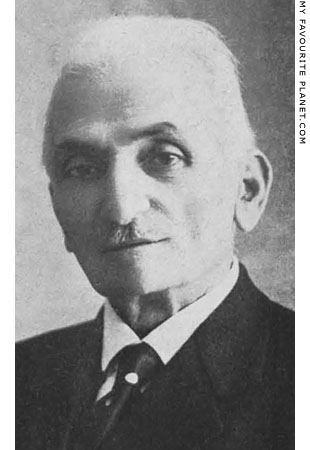
Konstantinos Kourouniotis
(Κωνσταντινος Κουρουνιωτης, 1872-1945),
the Greek archaeologist who excavated
at the sanctuary of Pan near Berekla
(today Neda), Arcadia in 1902. |
|
9. Terracotta figurine of Pan from Amphipolis
According to the museum label, this is "Papasilenus". There are a number of similar ceramic figurines of the Classical and Hellenistic periods depicting a seated Pan or Silenos in various museums. The moulding is usually not very detailed, and the distinctions may have been more evident in the painting which has now disappeared from most examples. The naked figures are shown seated on a rock with their elbows resting on raised knees which frame a pot belly. They usually play a wind instrument: Pan usually plays a syrinx (Pan pipes), has horns, cloven hoofs and sits cross-legged; while Silenos often plays a diaulos (double pipes), sits with his legs apart and has human feet and sometimes pointed ears (see photos, right). In this case the syrinx-playing figure clearly has cloven hoofs and appears to have small horns above the centre of his forehead.
10. The Cave of the Leibethrid Nymphs, Koroneia, Boeotia
The Cave of the Leibethrid Nymphs (Άντρο Λειβηθρίδων Νυμφών, also known as Σπήλαιο Νύμφης Κορώνειας, the Cave of the Koroneian Nymphs), is at an altitude of 820 metres, on the north slope of Mount Leibethrion (Λειβήθριον), a northern spur of the Mount Helikon range. It is located west of the village of Agia Triada (Αγία Τριάδα), around 7 km north of ancient Boeotian city of Koroneia (Κορώνεια, now a village with the same name), and 22 km south of Livadia, the nearest town.
The cave sanctuary is thought to be "the cave of the Nymphs called the Leibethrides" mentioned by Strabo, who wrote that it was founded by "Thracians who settled in Boeotia".
Strabo, Geography, Book 9, chapter 2, section 25, and Book 10, chapter 3, section 17. At Perseus Digital Library.
The location was also described by Pausanias:
"Some forty stades from Coroneia is Mount Libethrius, on which are images of the Muses and Nymphs surnamed Libethrian. There are springs too, one named Libethrias and the other Rock (Petra), which are shaped like a woman's breasts, and from them rises water like milk."
Pausanias, Description of Greece, Book 9, chapter 34, section 4. At Perseus Digital Library.
The archaeological finds from the site are in Thebes Archaeological Museum.
11. Terracotta figure playing a tympanon from Abdera
This figure in Abdera Archaeological Museum is exhibited in a display case containing several ceramic figures depicting deities and other characters connected with ancient Greek religious mythology. It is not placed alongside the terracottas of Pan, including Pan playing a syrinx (see above), but with a mixed group of small objects labelled "Dionysos, Satyrs and Silenoi. 2nd c. BC - 2st c. AD." This suggests that those who assembled the display did not consider this figure to be Pan.
Apart from a small number of academic articles, very little detailed information about the archaeological finds from Abdera has yet been published, and there is no guide book either to the site or the museum. However, the Lexicon Iconographicum Mythologiae Classicae (LIMC) records an identification of the artifact as a depiction of Pan:
"55. Clay statuette. Abdera, Mus. 1161. - Marquardt 6. 7 pl. 1, 1. - 4th/3rd cent. B.C. - Playing tympanon, long cloak, goat legs."
Lexicon Iconographicum Mythologiae Classicae (LIMC), Volume VIII, 1: Thespiades-Zodiacus. Et supplementum Abila - Thersites, "Pan" No. 55, page 926. Artemis Verlag, Zürich und Düsseldorf, 1997. At the Internet Archive.
The description also begs the question, what is the distinction between a figurine and a statuette?
12. Pan on the lid of a lebes from Larino
The vessel was exhibited as part of the temporary exhibition The gift of Dionysos in the Thessaloniki Archaeological Museum, 13 July 2011 - 30 September 2012. So far I have been unable to discover further details of the exhibits on loan from the Molise region of south-central Italy.
See further information about the exhibition on the Dionysus page.
13. Statue of Pan in the Fitzwilliam Museum, Cambridge
Marble headless statue of Pan, found by Edward Daniel Clarke (1769-1822) at the Cave of Pan, on the north slope of the Athens Acropolis.
Fitzwilliam Museum, Cambridge. Inv. No. GR.4.1865.
Early Roman period, 1st - 2nd century AD.
Height 86 cm, width 33 cm, depth 27 cm. Approx. weight 166 kg.
Donated to the museum by Edward Daniel Clarke in 1865.
See:
data.fitzmuseum.cam.ac.uk/id/object/65758
Edward Daniel Clarke, Greek marbles brought from the shores of the Euxine, Archipelago, and Mediterranean and deposited in the vestibule of the public library of the University of Cambridge, pages 9-10, number XI. Cambridge University Press, 1809. At the Internet Archive.
14. Hellenistic "shield coins"
For further information and discussion on "shield coins", see:
Christopher A. Matthew, For valour: the ‘shield coins’ of Alexander and the Successors. In: Journal of the Numismatic Association of Australia, Volume 20, 2009 (2010), pages 15-34. Illustrated, with bibliography. Both sides of the Pan coin shown in fig. 2c, page 17. A PDF is available online, but at present I do not have the link.
15. The Pan mosaic in the Naples museum
See: Domenico Monaco, Complete handbook to the National Museum in Naples, "Reserved Cabinet (Oggetti osceni)", page 62. English edition, edited by Eustace Neville-Rolfe. Naples, 1905. At the Internet Archive.
16. The Pan statue in the Palazzo Massimo alle Terme
Some sources give the Invoice Number 52399. I have used the number on the museum label.
17. For further discussion about this particular passage of Pliny, see Doidalsas. |
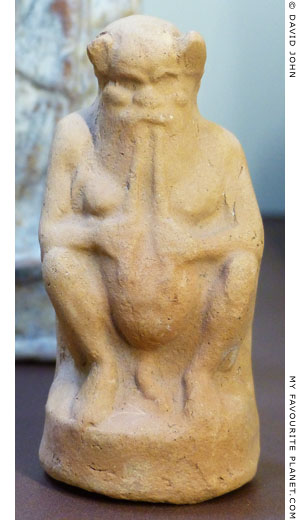
Ceramic figurine of Silenos, seated
and playing a diaulos (double pipes).
Mid 5th centuy BC. From the Cave of
the Leibethrid Nymphs, at Agia Triada,
near Koroneia, Boeotia, central Greece.
Thebes Archaeological Museum. |
| |
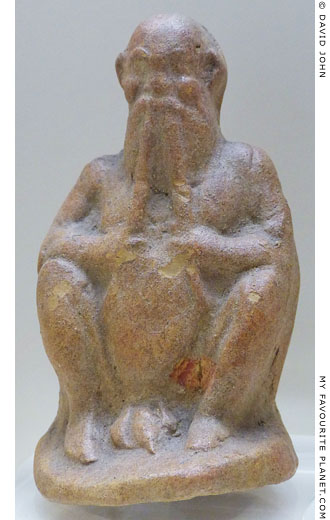
Ceramic figurine of a seated Silen or
Silenos playing an diaulos (double pipes).
5th - 4th century BC.
Piraeus Archaeological Museum. |
| |
| |
Photos on this page were taken during
visits to the following museums:
Germany
Berlin, Altes Museum
Berlin, Bode Museum
Berlin, Pergamon Museum
Dresden, Albertinum, Skulpturensammlung
Hamburg, Museum für Kunst und Gewerbe
Potsdam, Neues Palais, Sanssouci
Greece
Abdera Archaeological Museum, Thrace
Amphipolis Archaeological Museum, Macedonia
Athens, Kerameikos Archaeological Museum
Athens, National Archaeological Museum
Corinth Archaeological Museum
Delos Archaeological Museum
Kos Archaeological Museum
Kos, Asklepieion archaeological site
Marathon Archaeological Museum
Olympia Archaeological Museum
Patras Archaeological Museum
Pella Archaeological Museum, Macedonia
Piraeus Archaeological Museum
Pyrgos Archaeological Museum
Thasos Archaeological Museum, Macedonia
Thasos acropolis, Macedonia
Thebes Archaeological Museum
Thessaloniki Archaeological Museum, Macedonia
Veria Archaeological Museum, Macedonia
Italy
Milan, Civic Archaeological Museum
Naples, National Archaeological Museum
Rome, Barracco Museum
Rome, Capitoline Museums, Palazzo dei Conservatori
Rome, Capitoline Museums, Palazzo Nuovo
Rome, National Museum of Rome, Palazzo Altemps
Rome, National Museum of Rome, Palazzo Massimo alle Terme
Italy - Sicily
Agrigento Regional Archaeological Museum
Netherlands
Amsterdam, Allard Pierson Museum
Leiden, Rijksmuseum van Oudheden
Turkey
Istanbul Archaeological Museum
Istanbul, Great Palace Mosaic Museum
Izmir Archaeological Museum
Izmir Museum of History and Art
United Kingdom
London, British Museum
Oxford, Ashmolean Museum
Many thanks to the staff of these museums. |
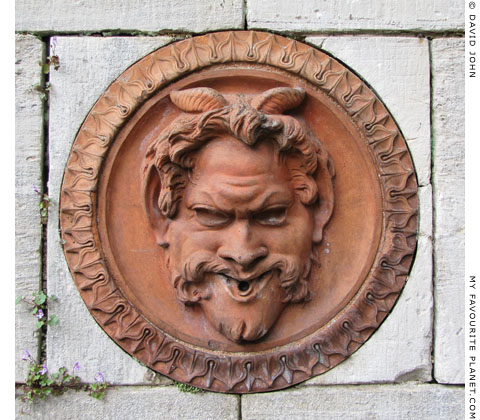
Round terracotta plaque with a relief of the head
of Pan as a water spout of a fountain in the
gardens of Sanssouci, Potsdam, Germany. |
|
| Photos and articles © David John, except where otherwise specified. |
 |
Visit the My Favourite Planet Group on Facebook.
Join the group, write a message or comment,
post photos and videos, start a discussion... |
|
|
| |
| Copyright © 2003-2025 My Favourite Planet | contents | contributors | impressum | sitemap |
| |





